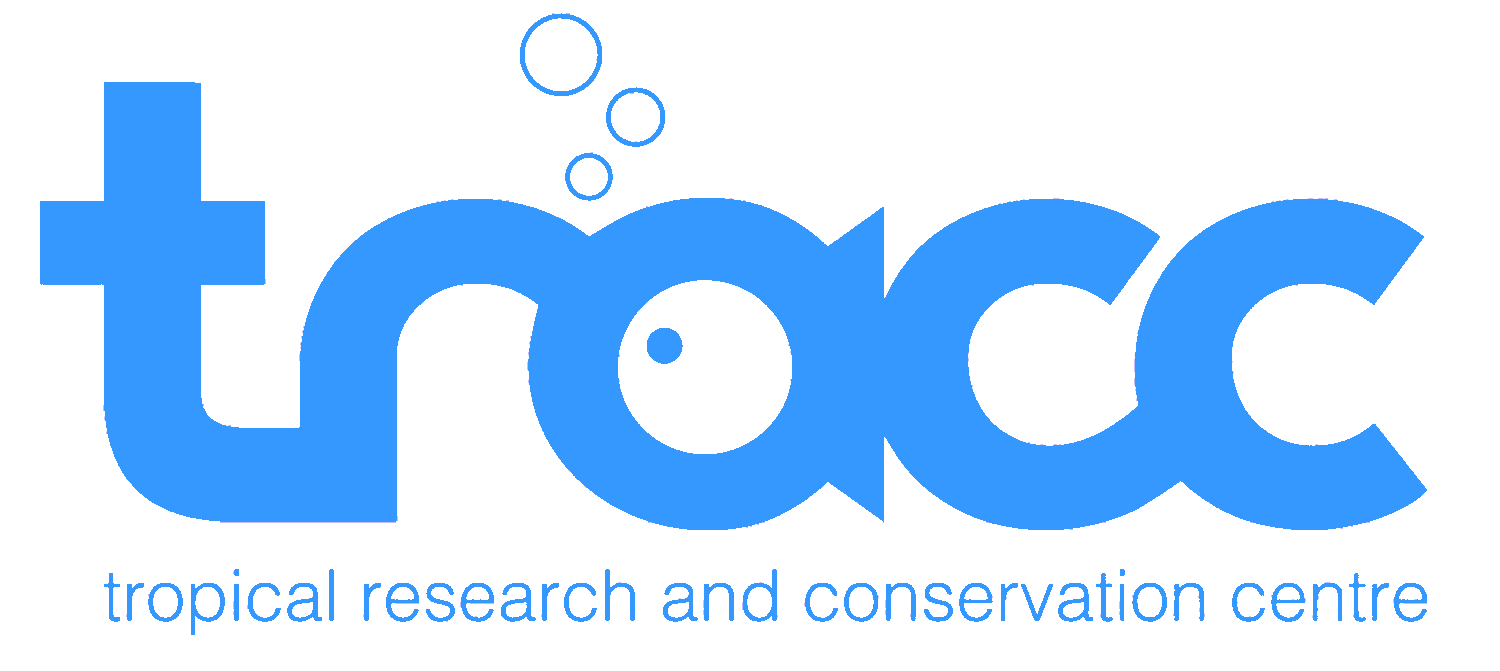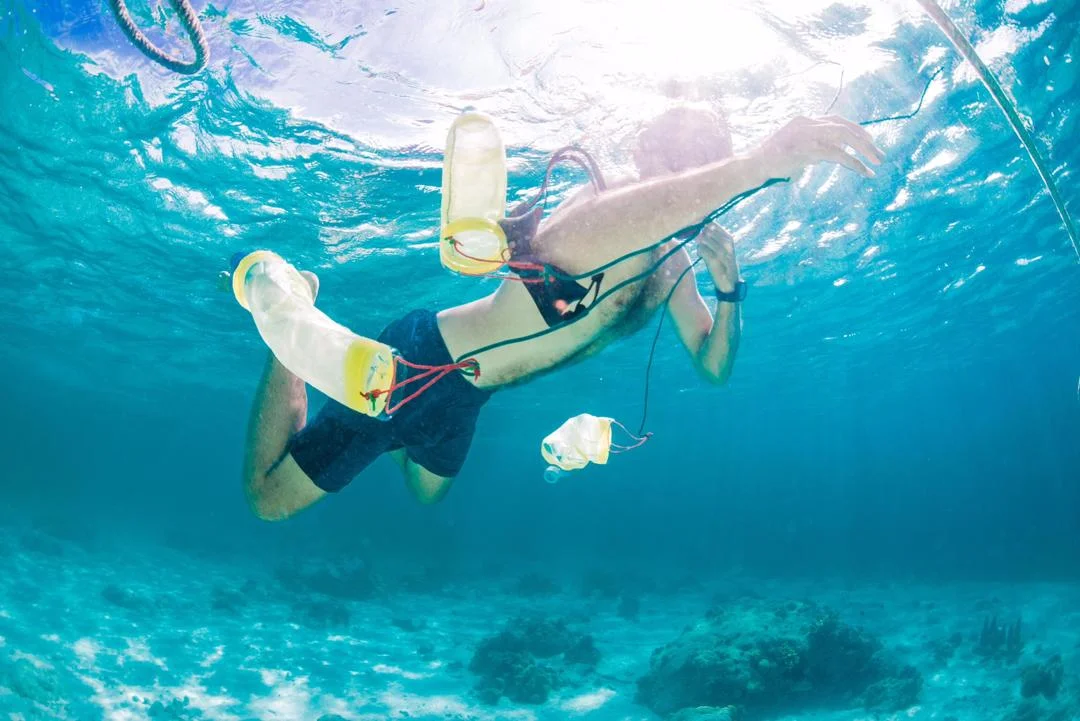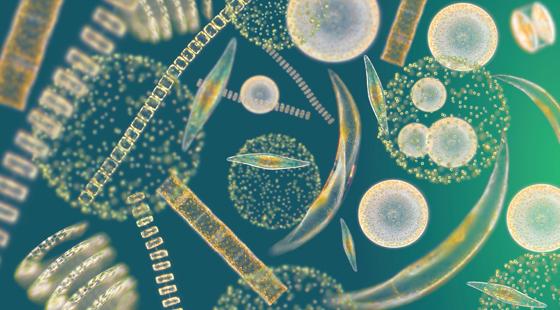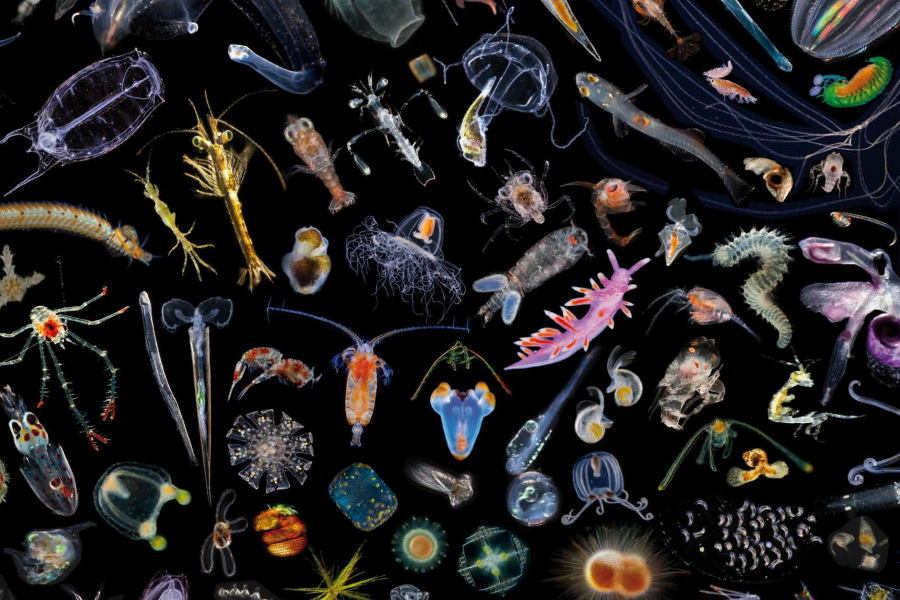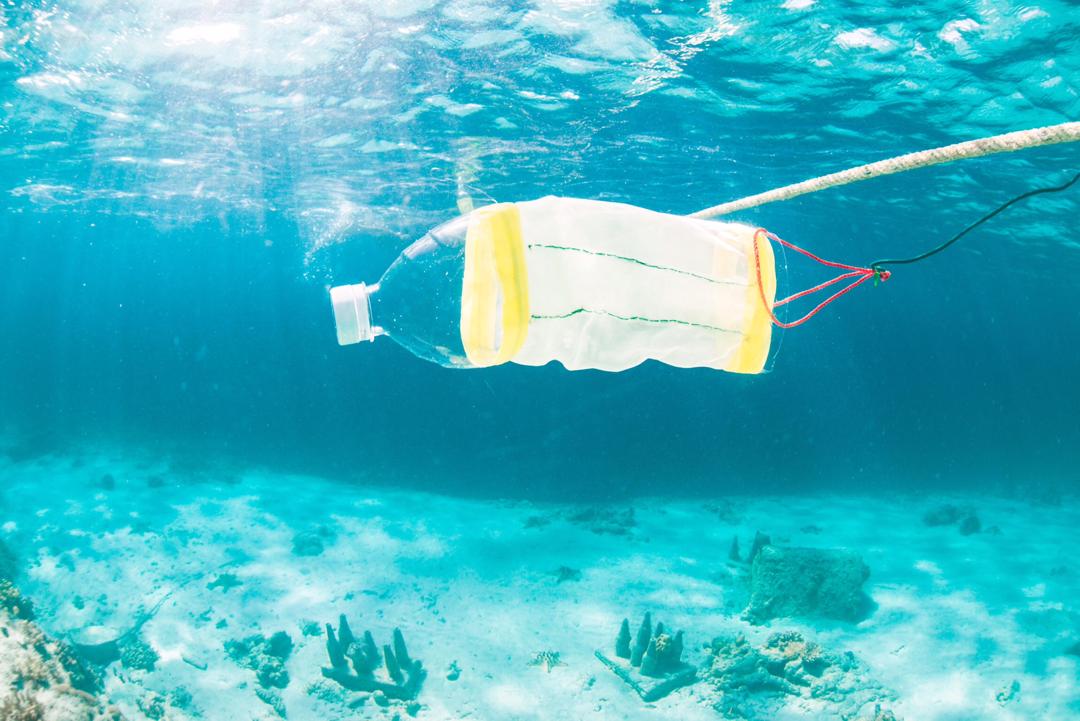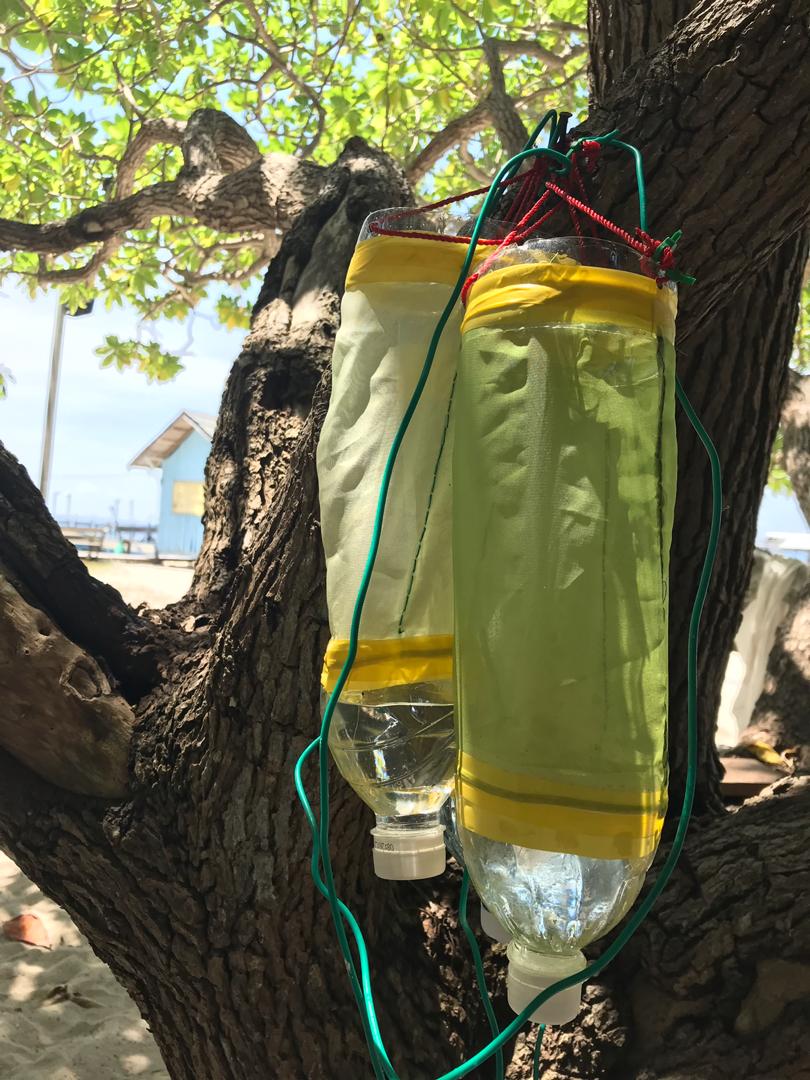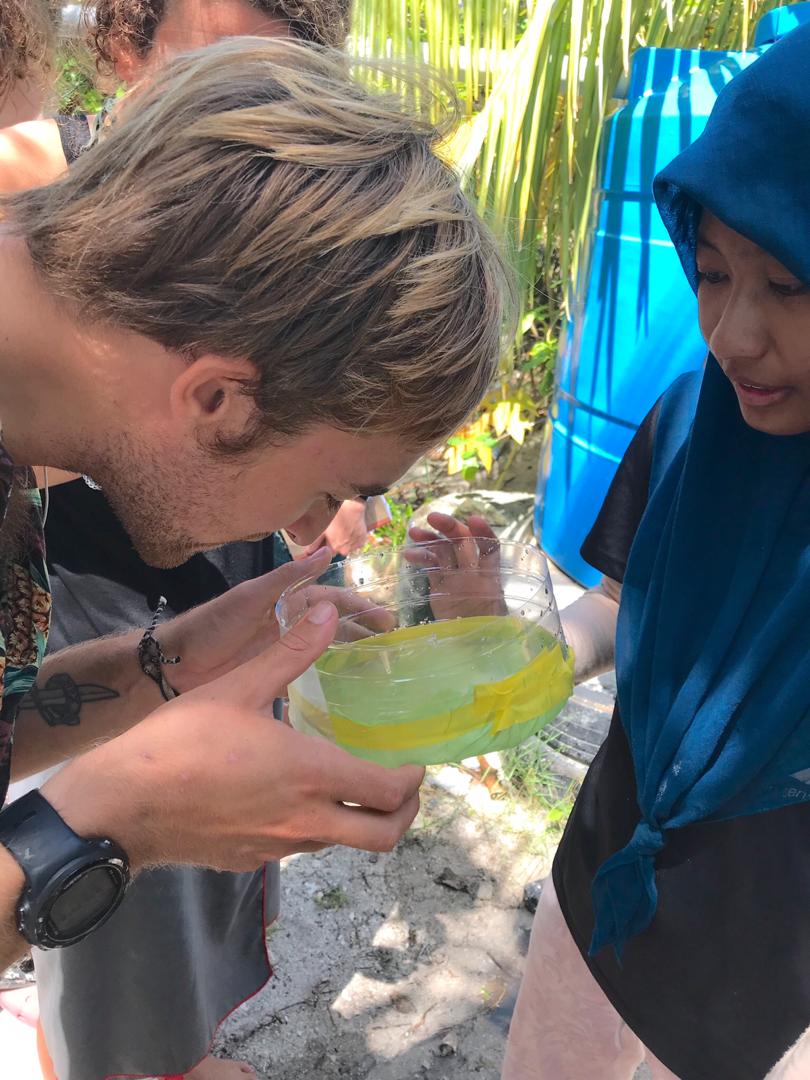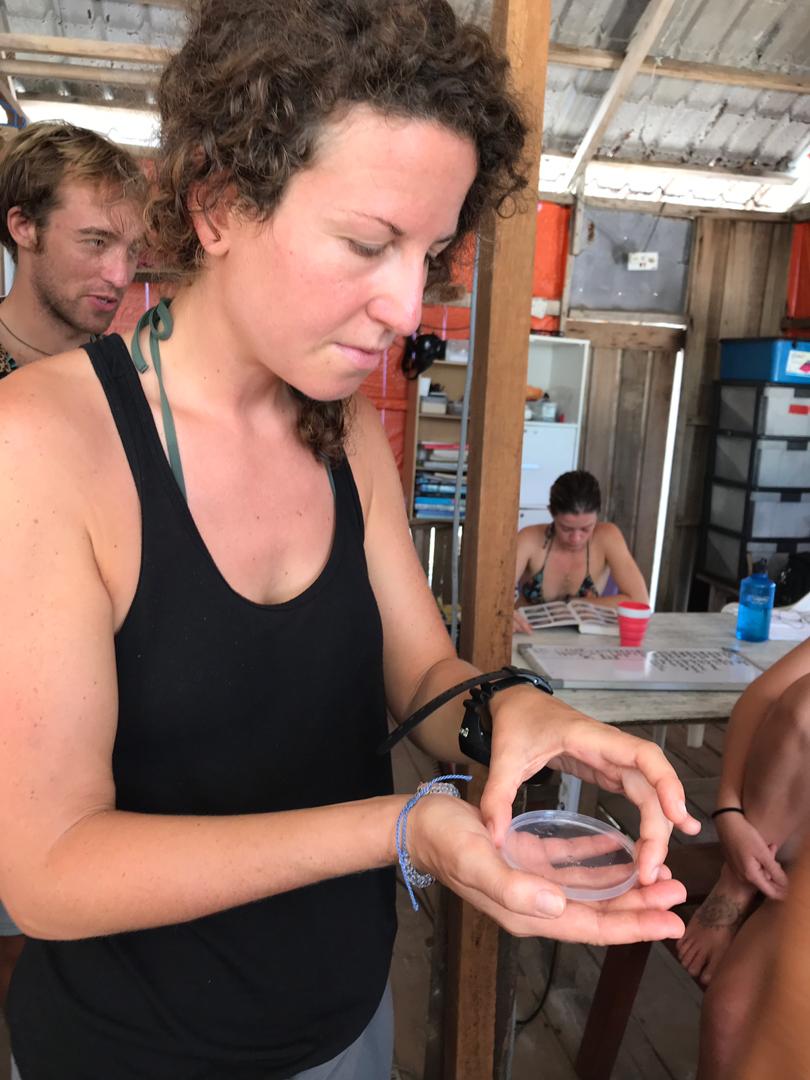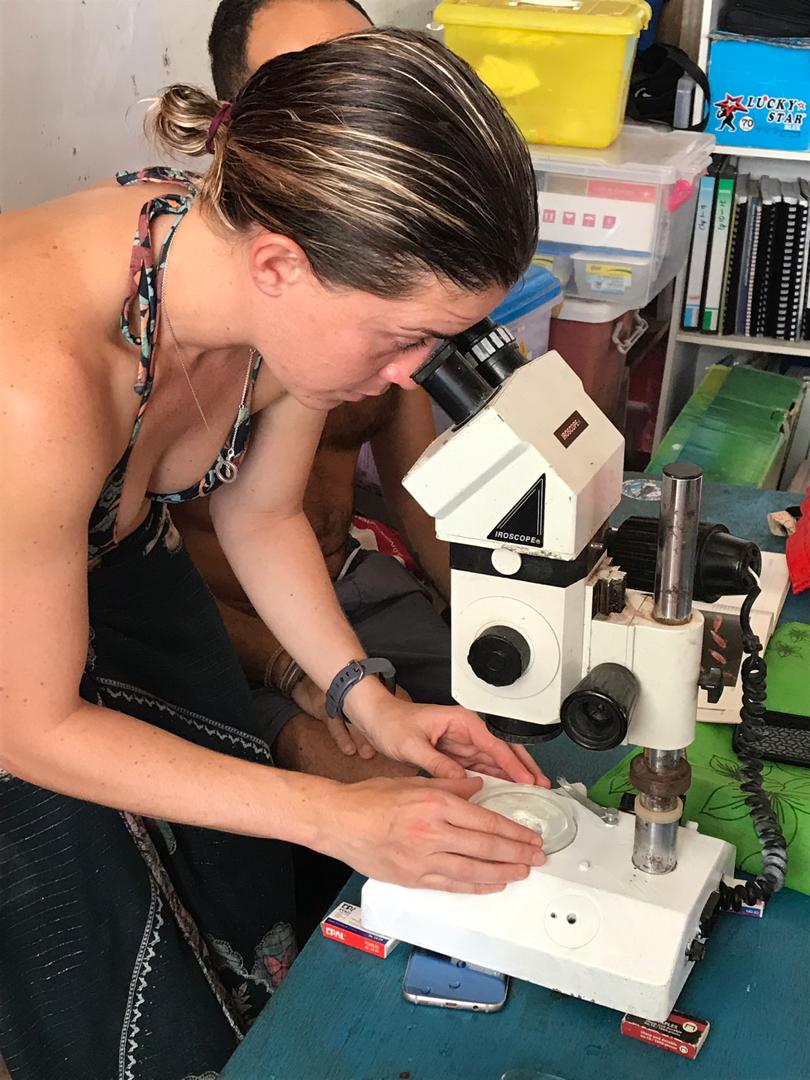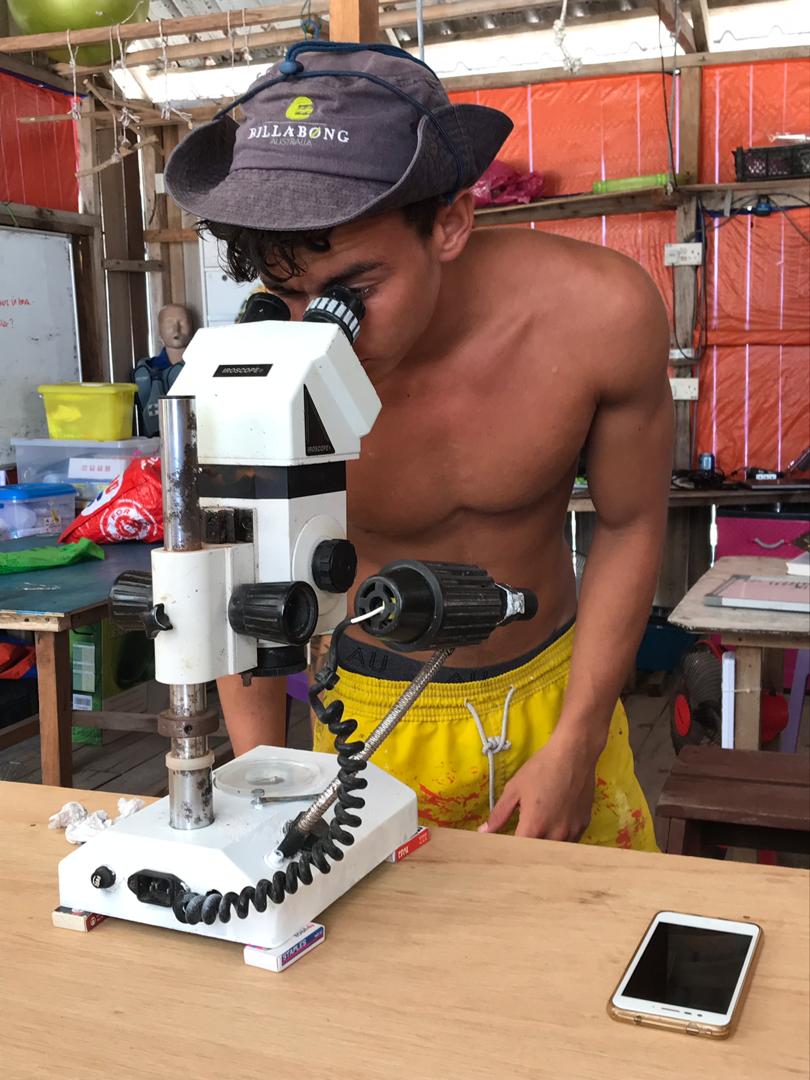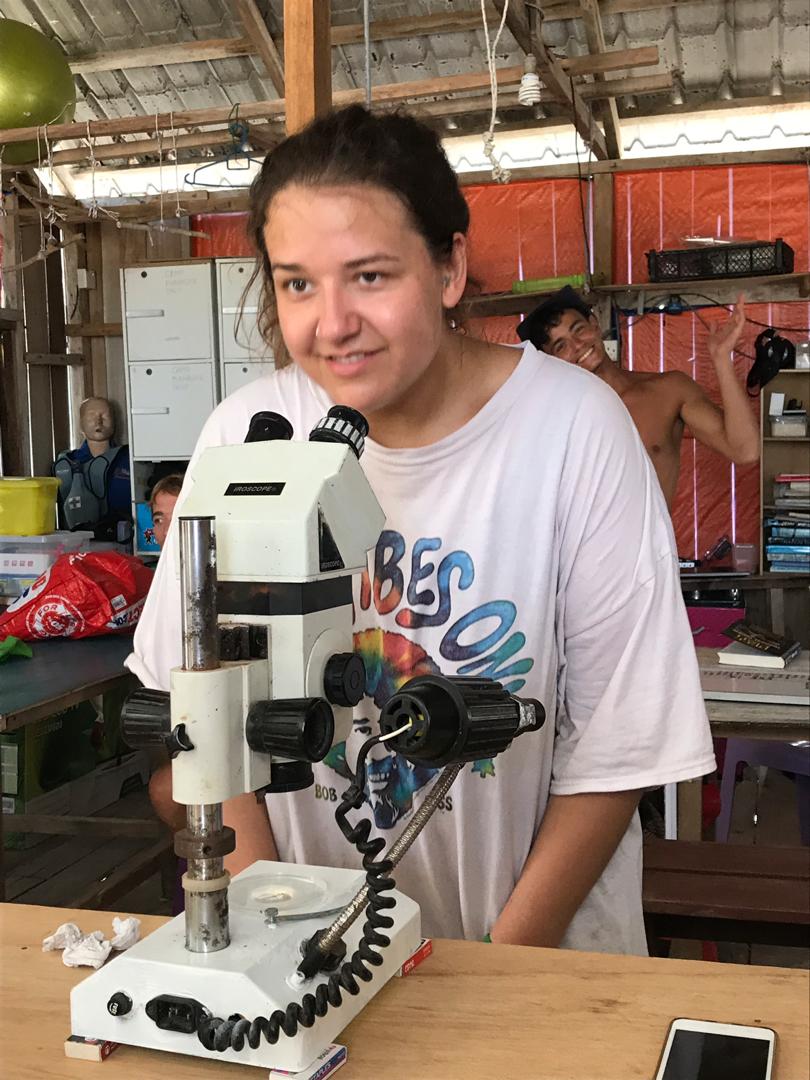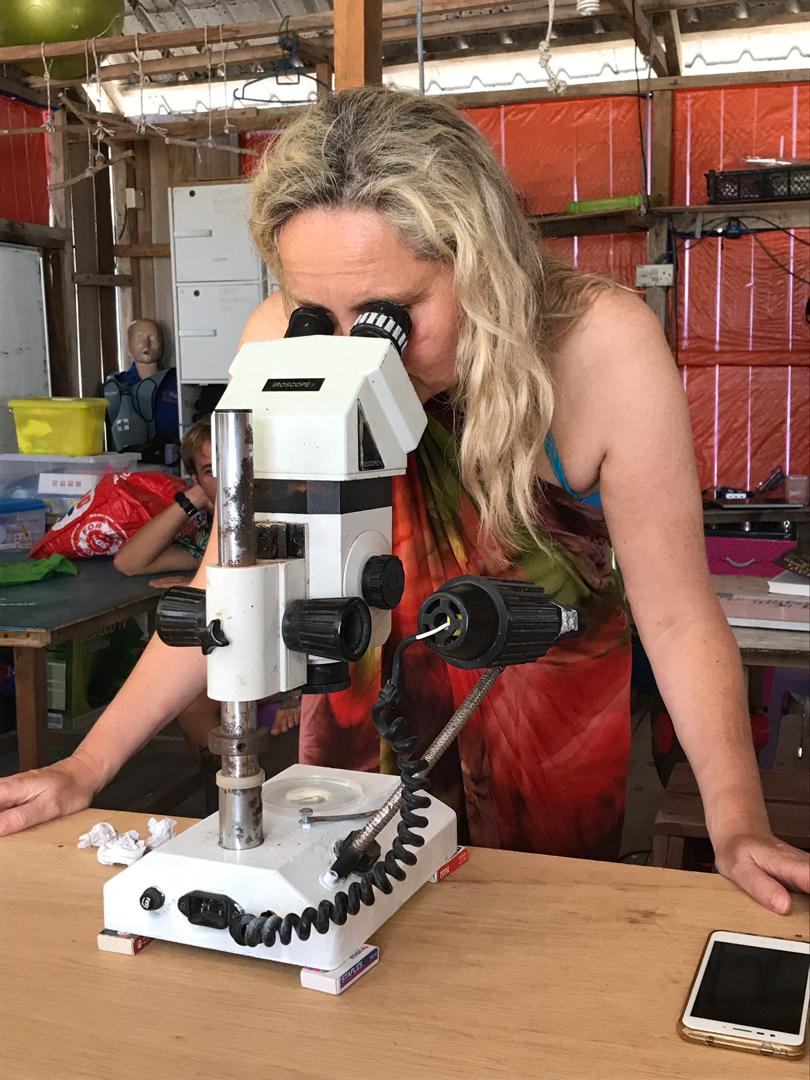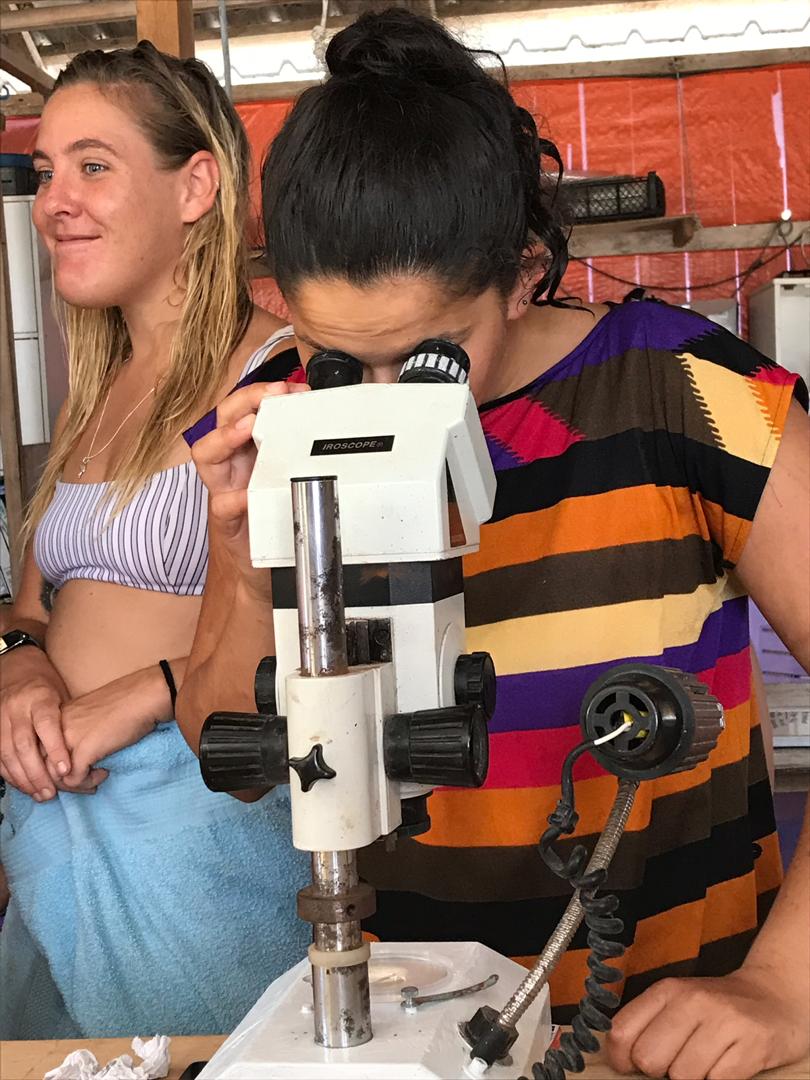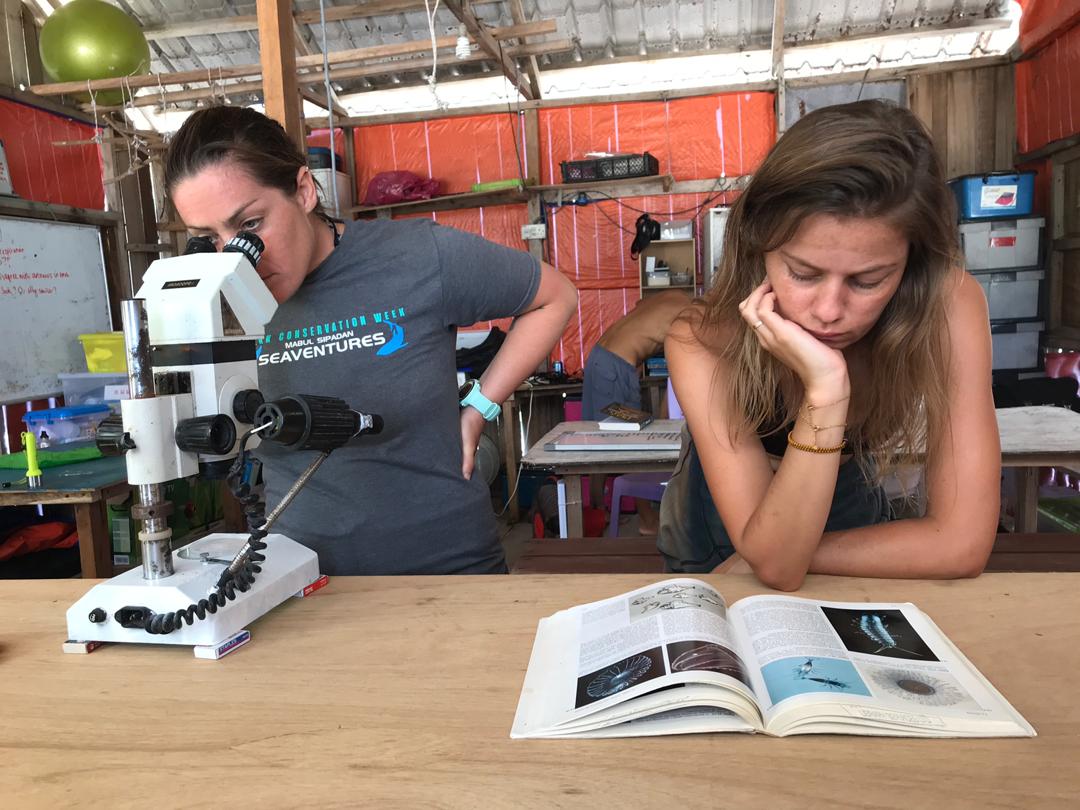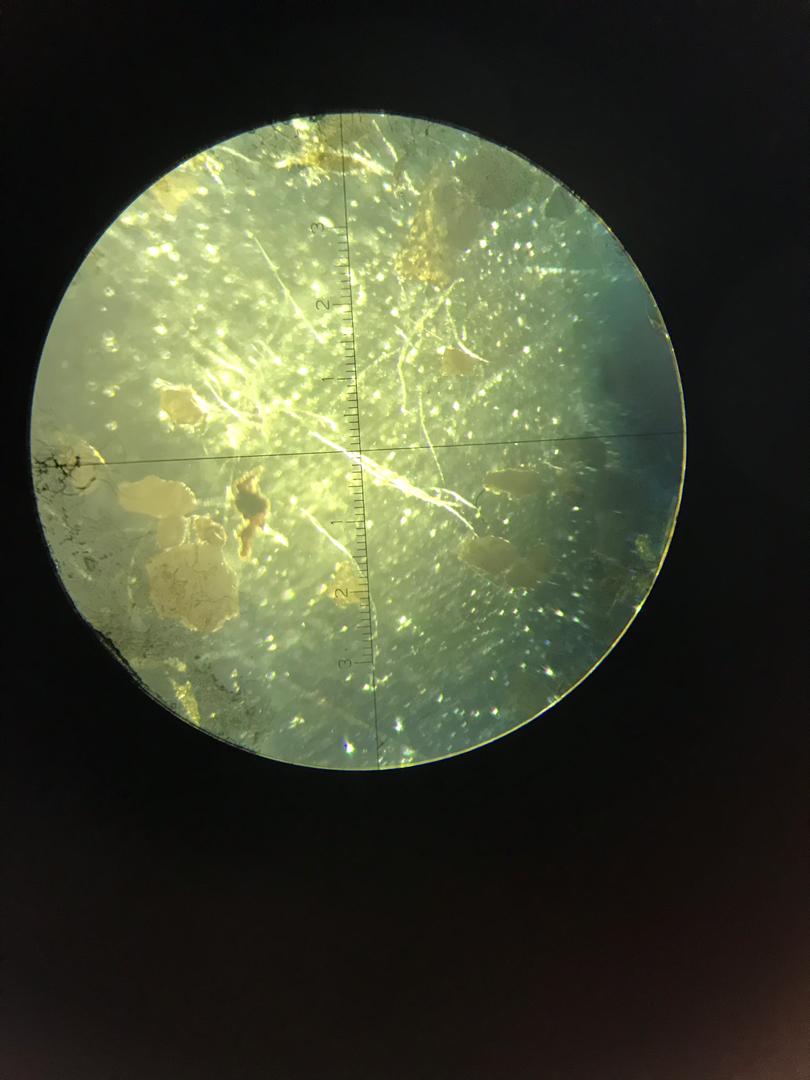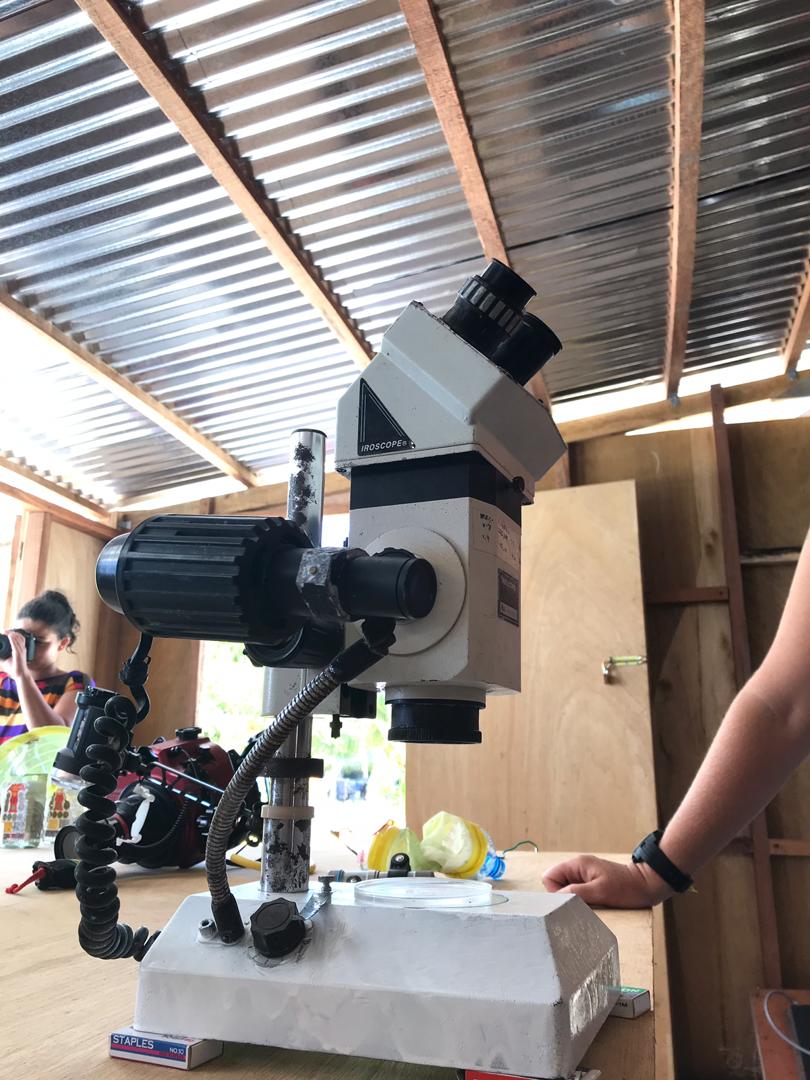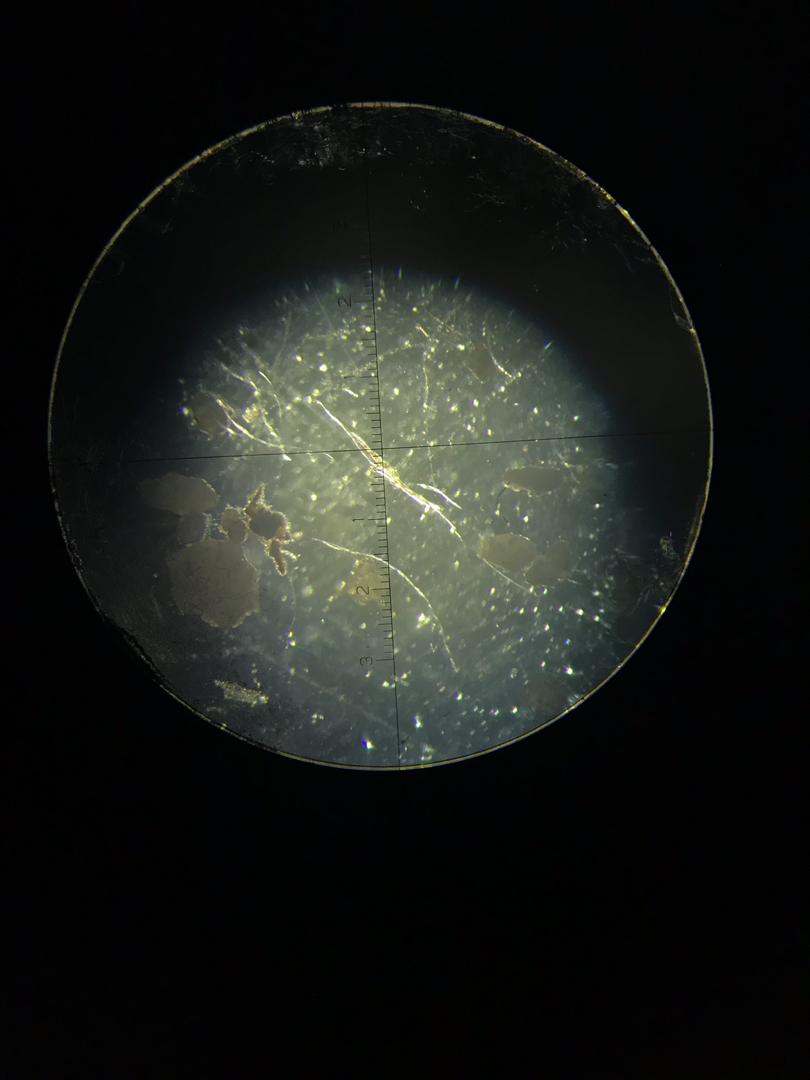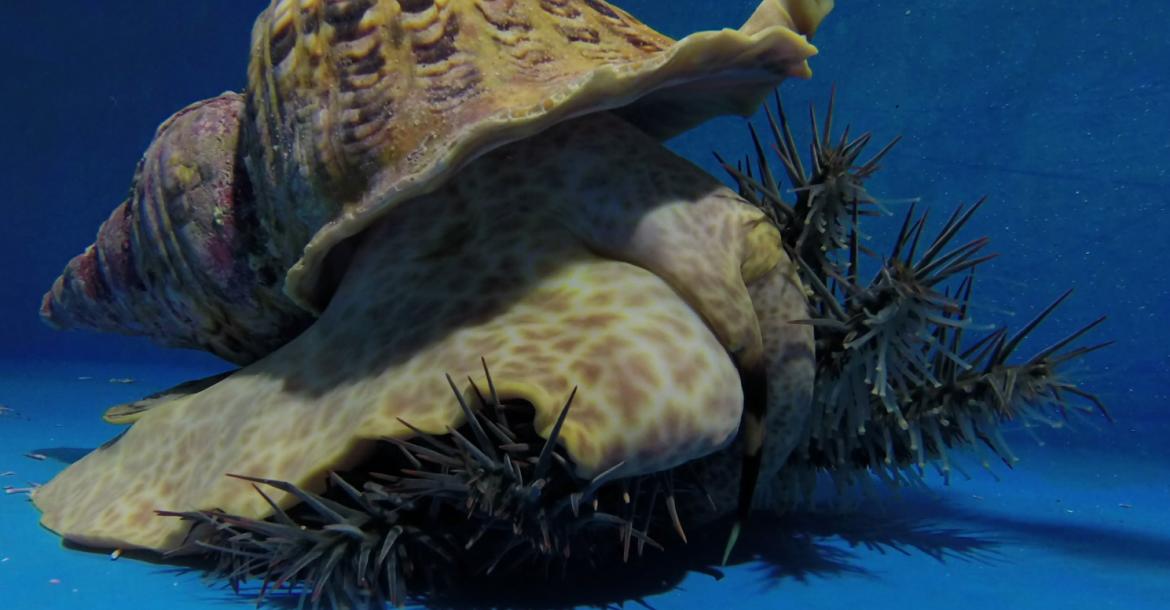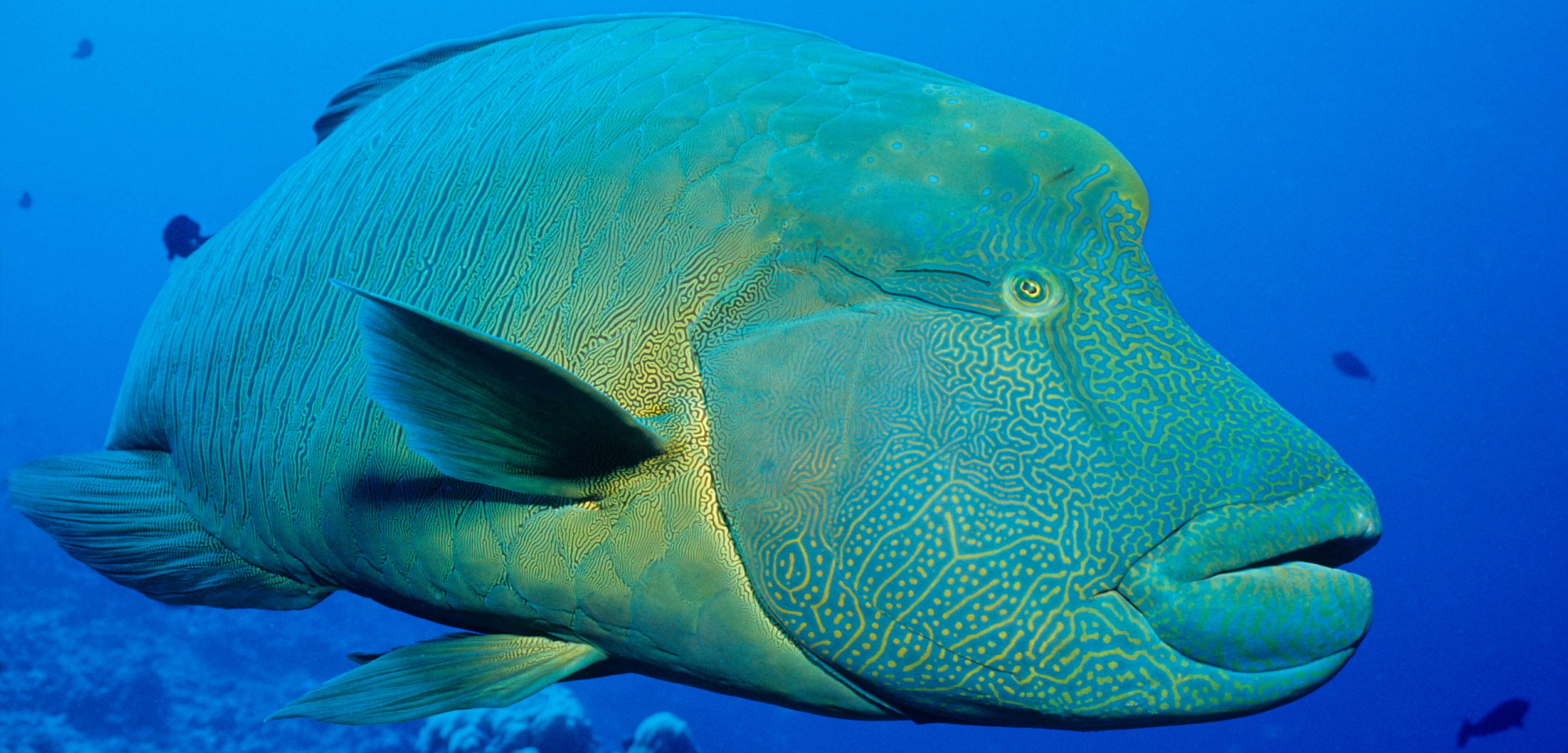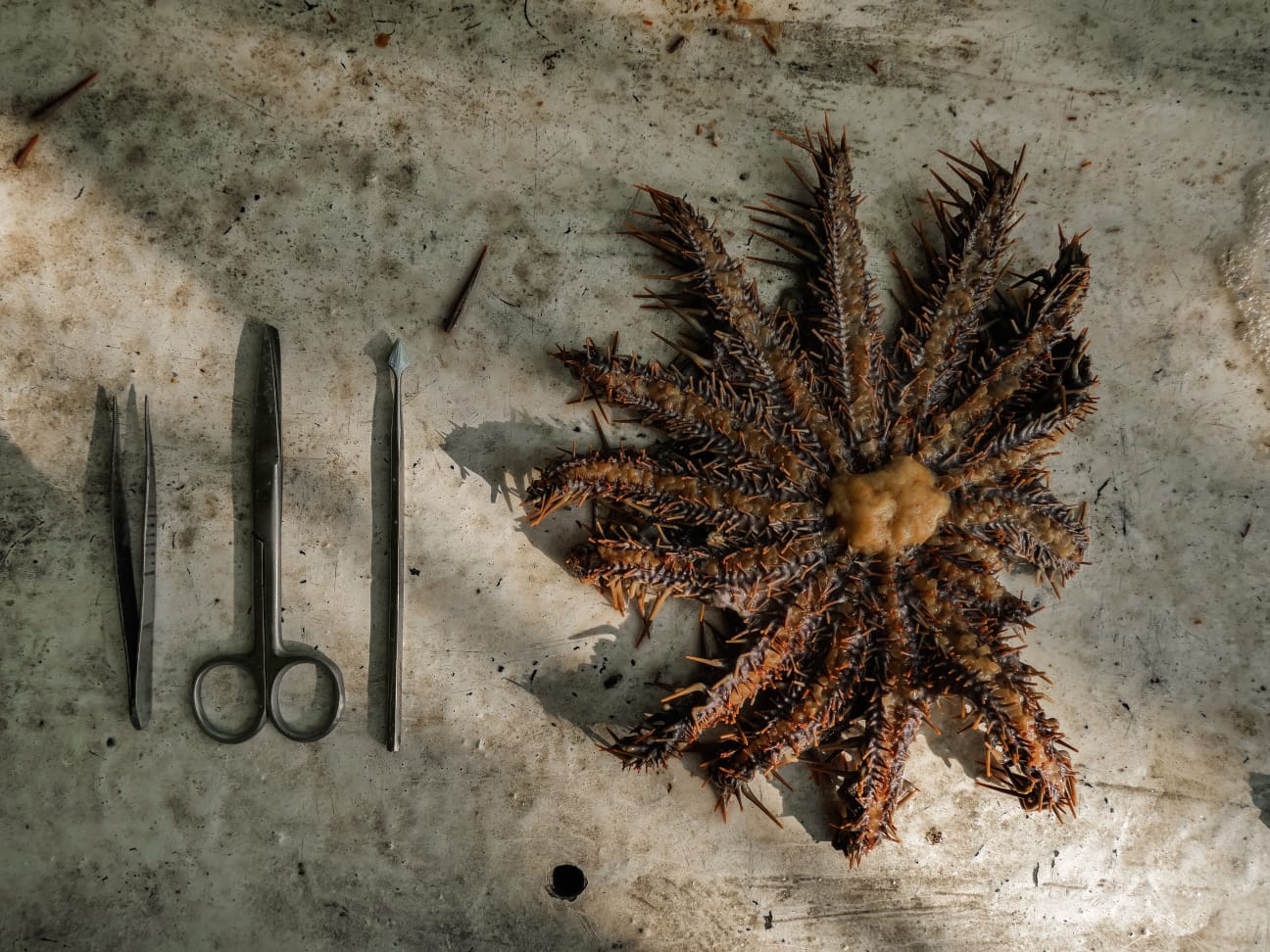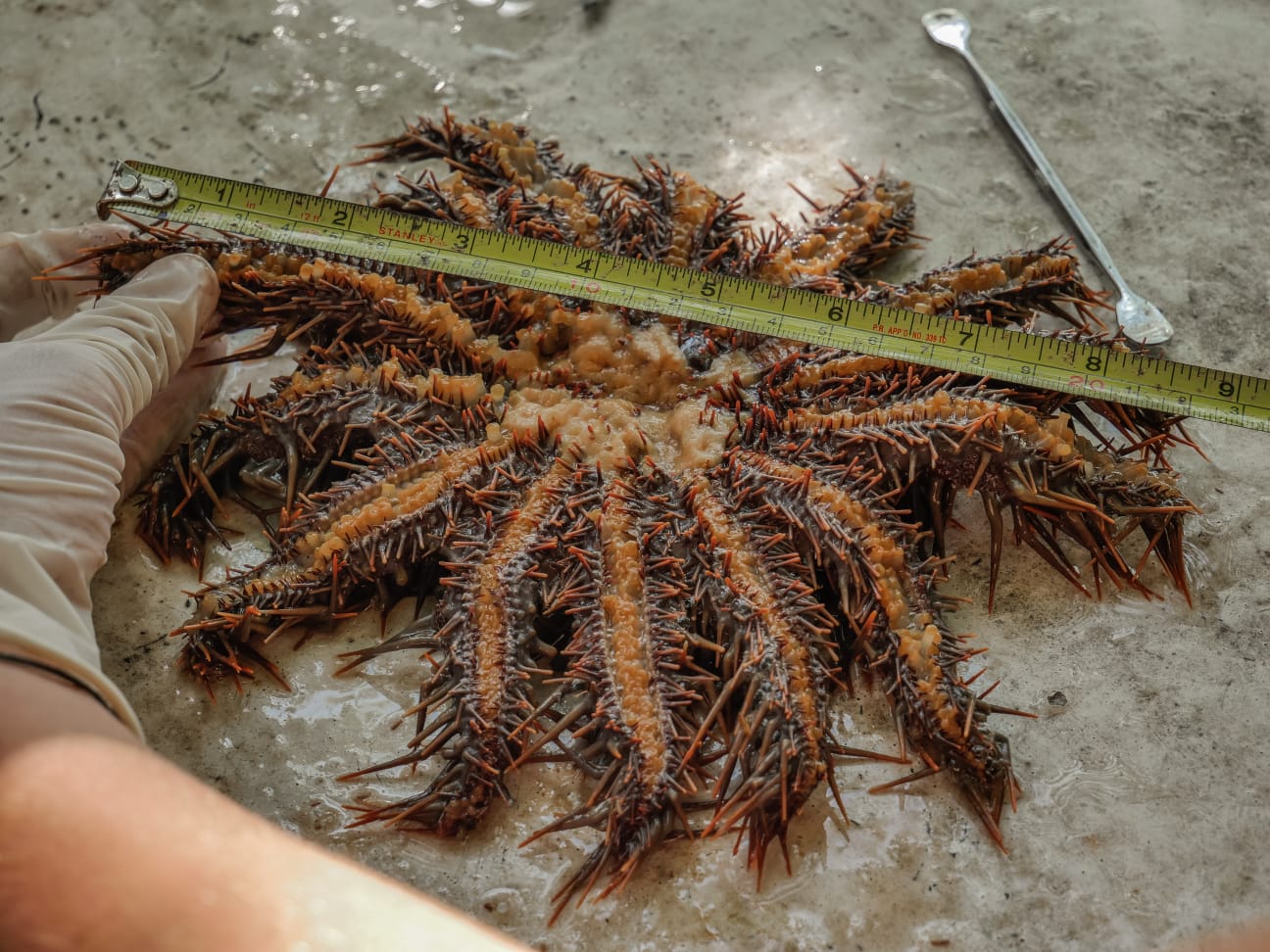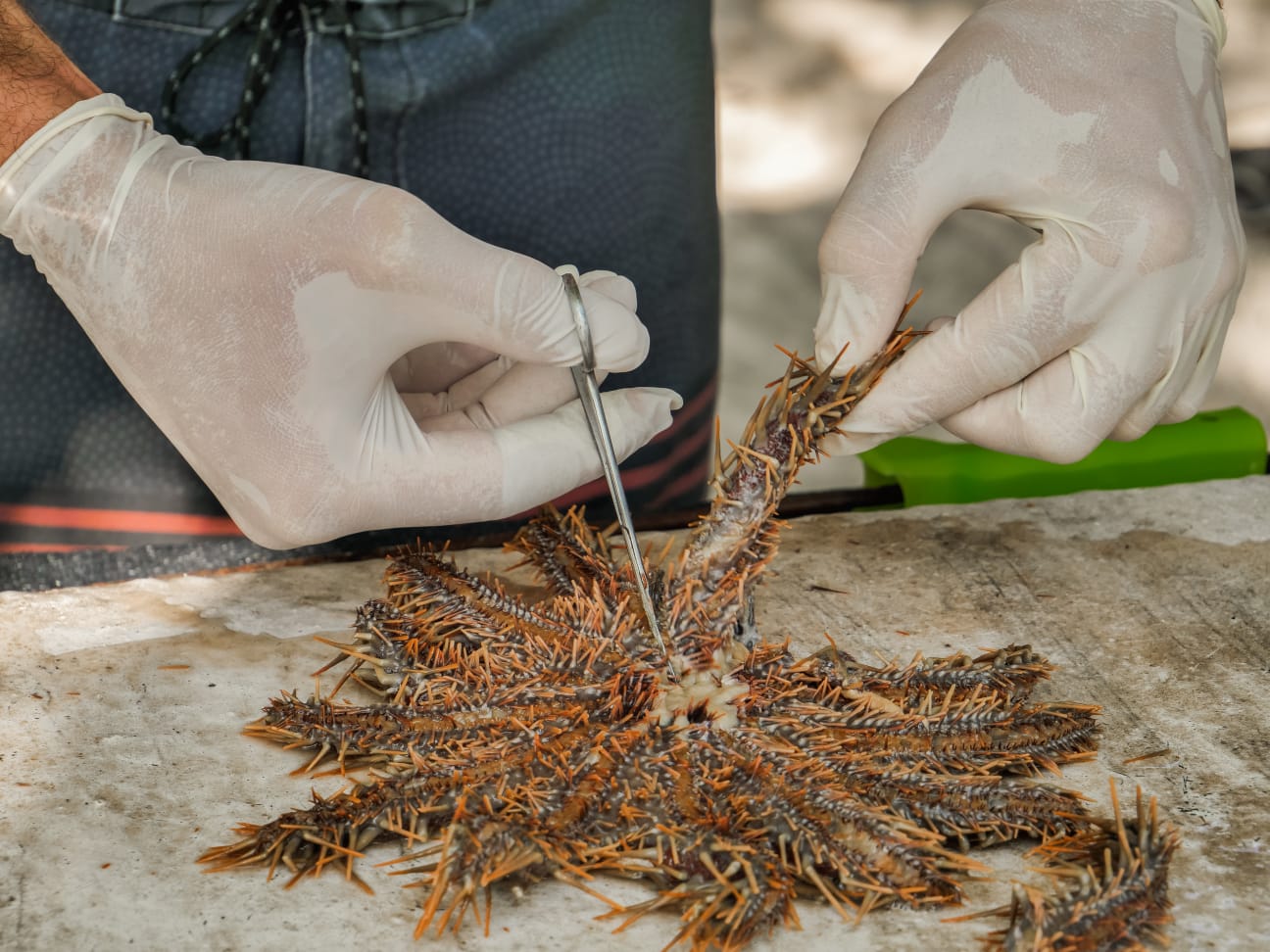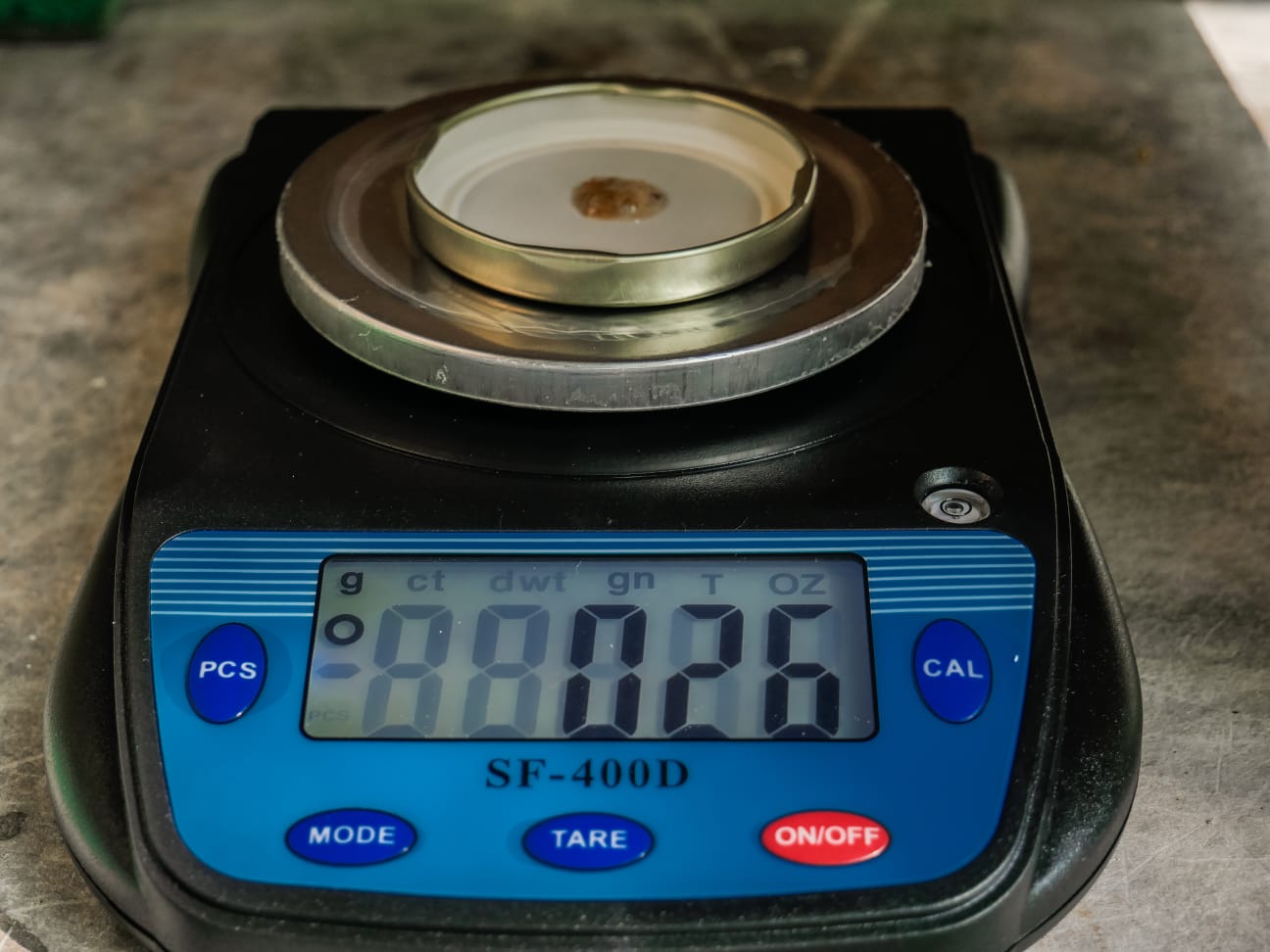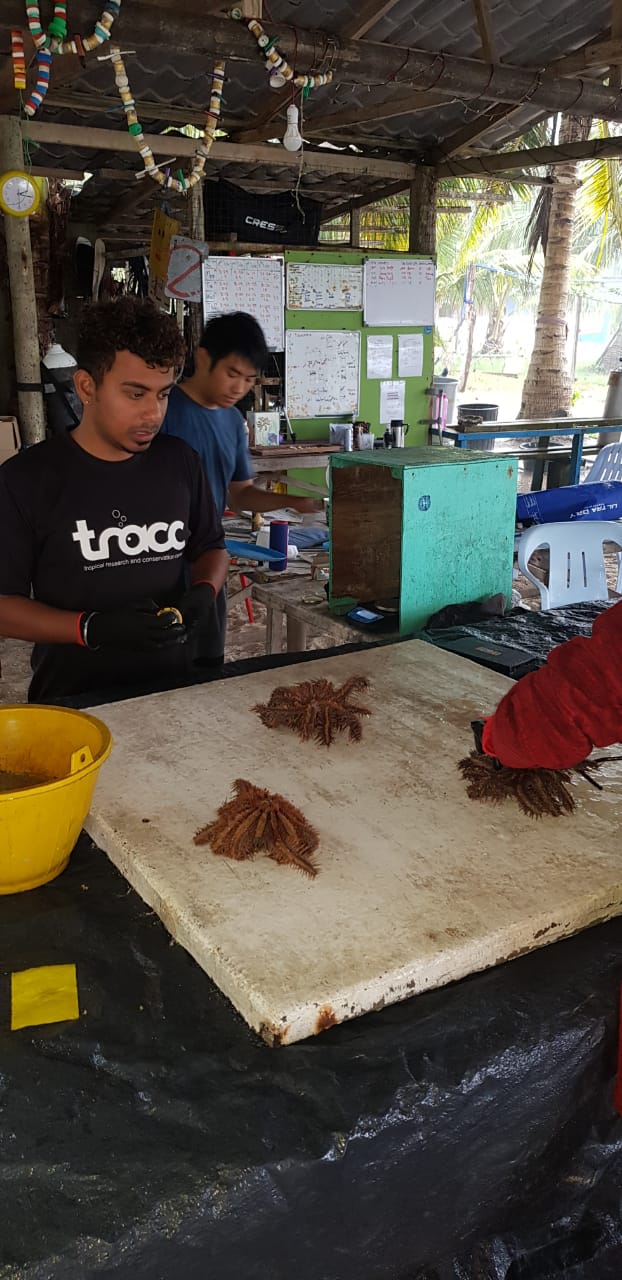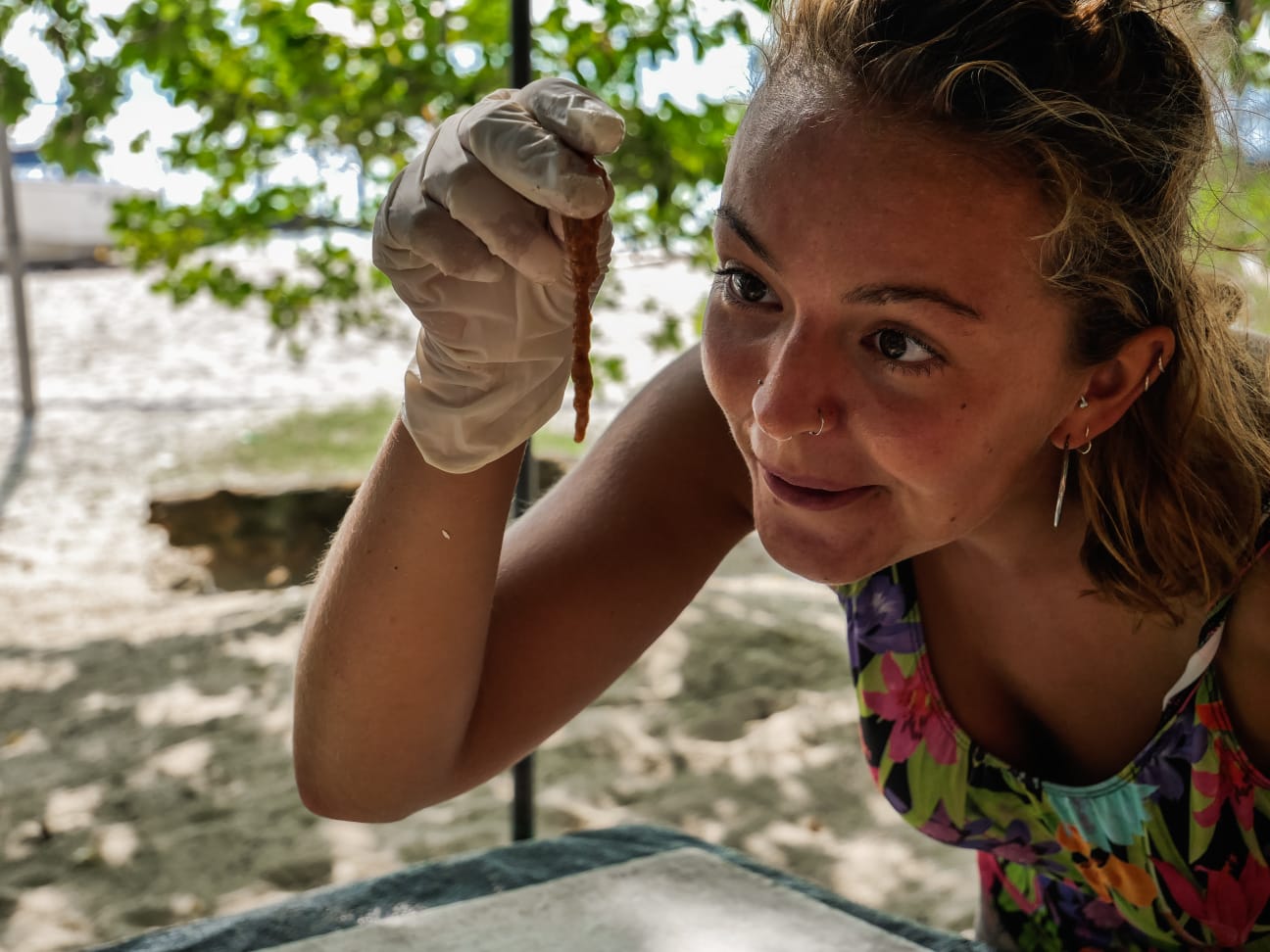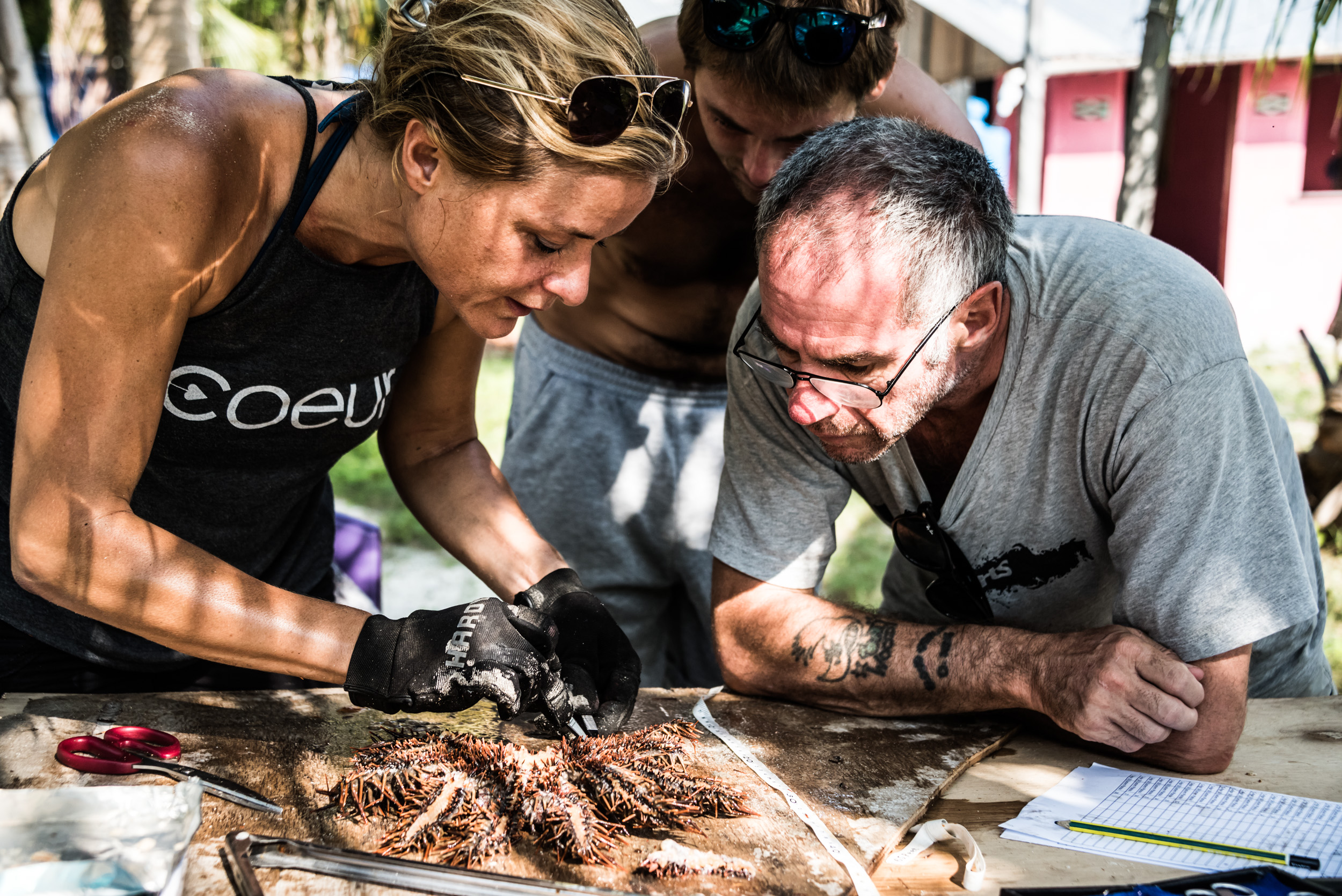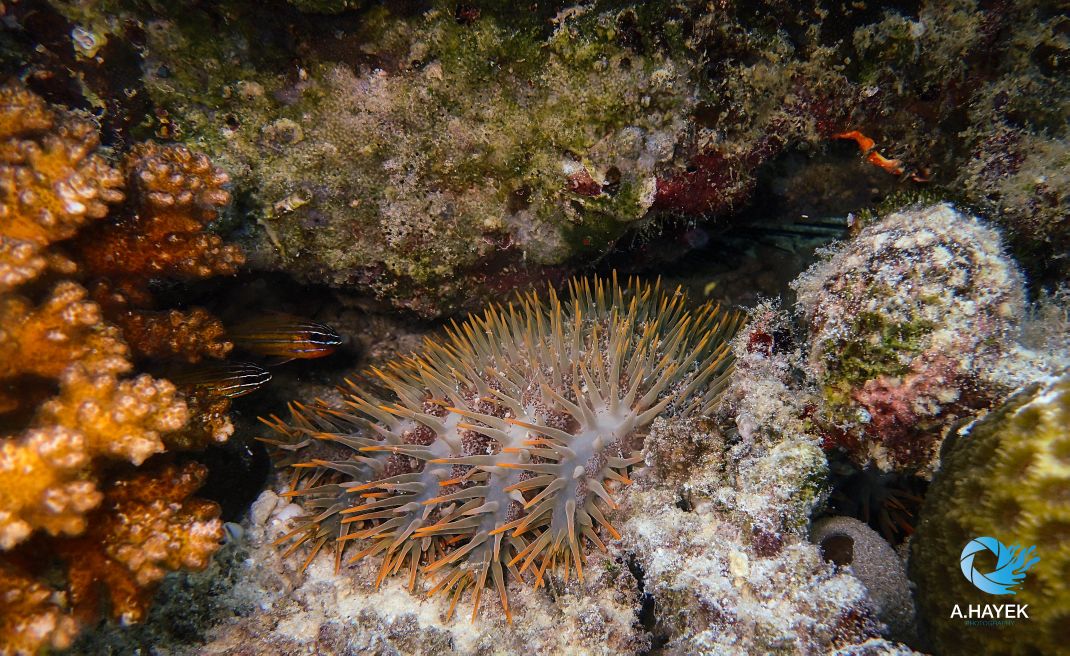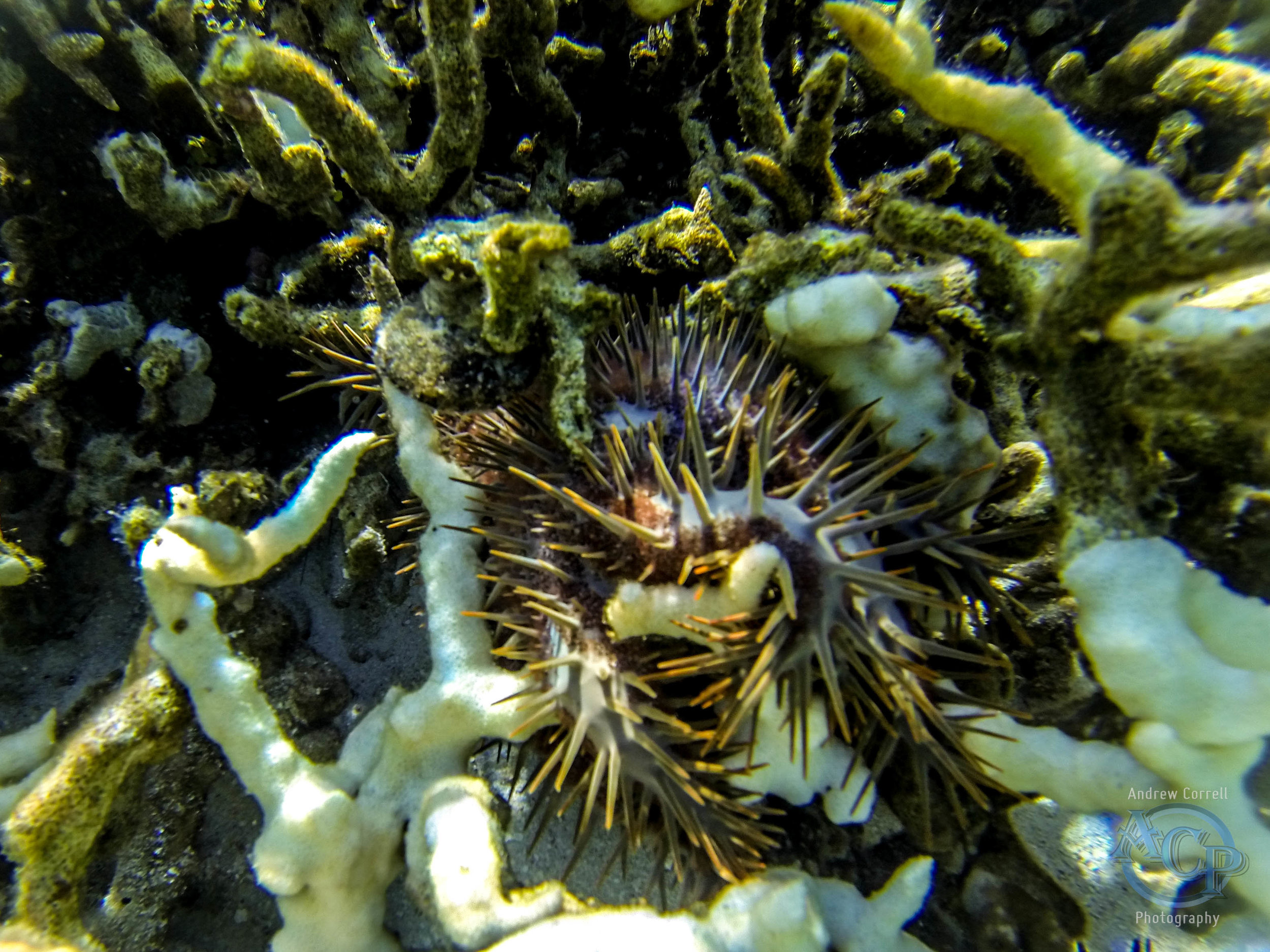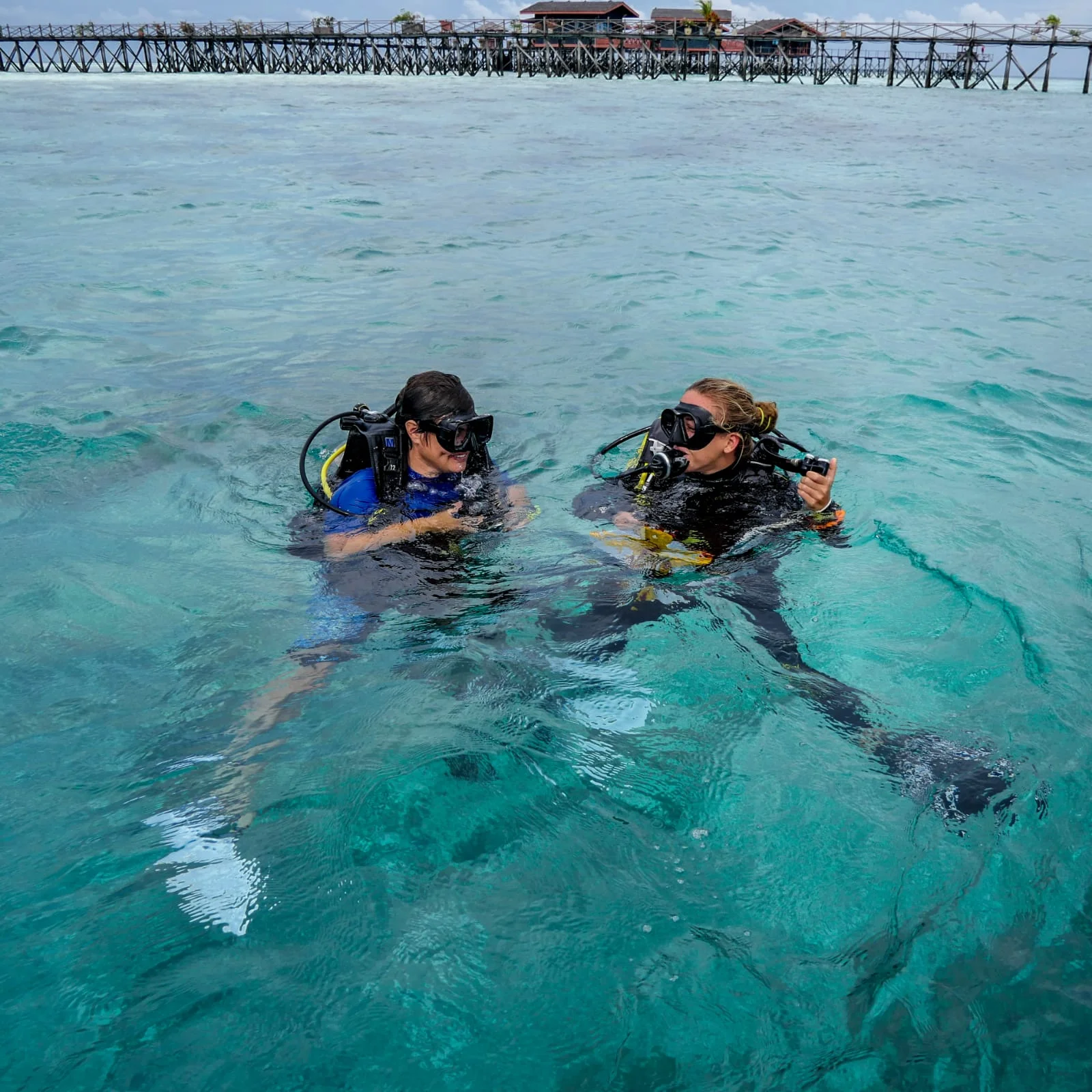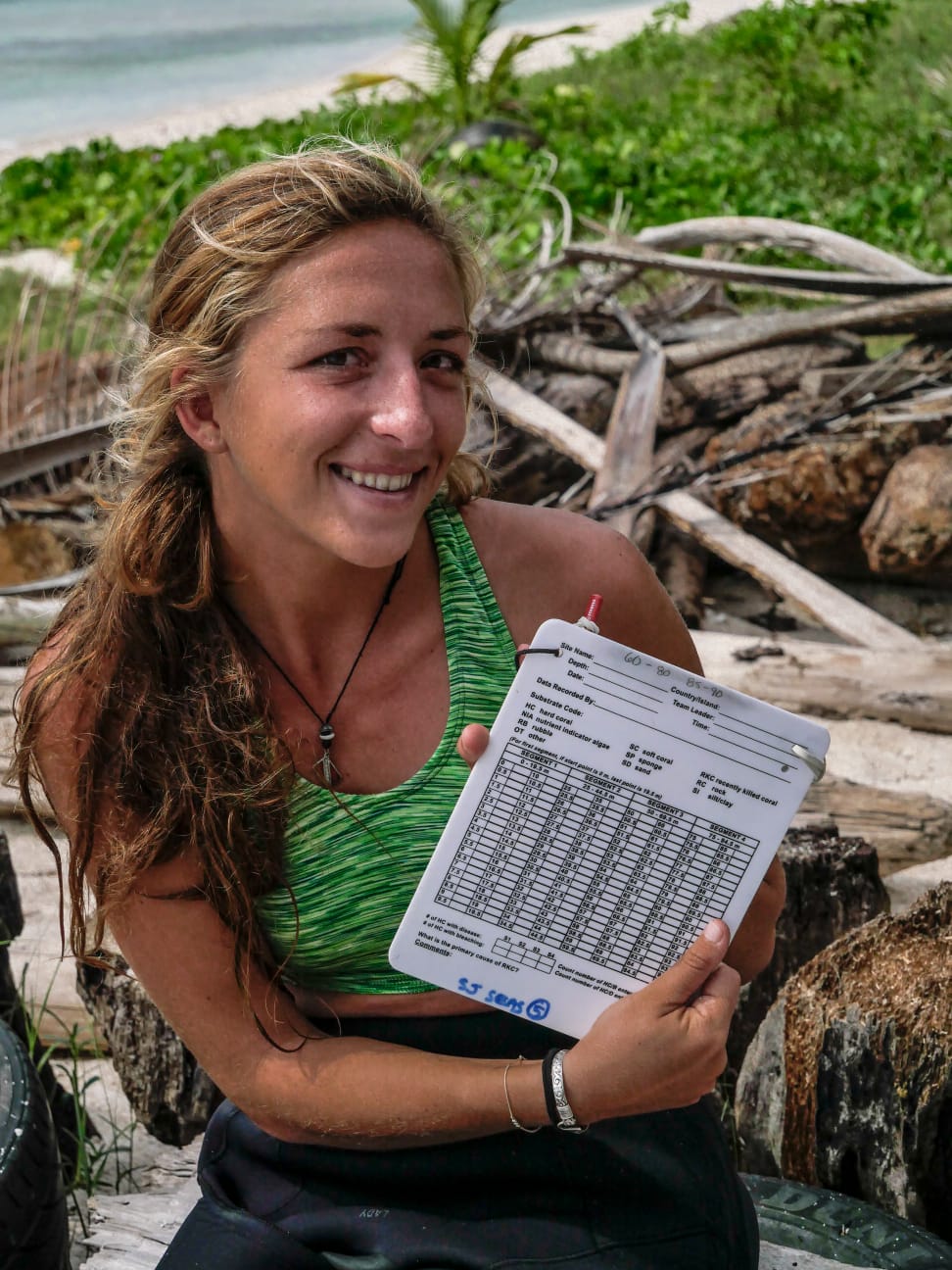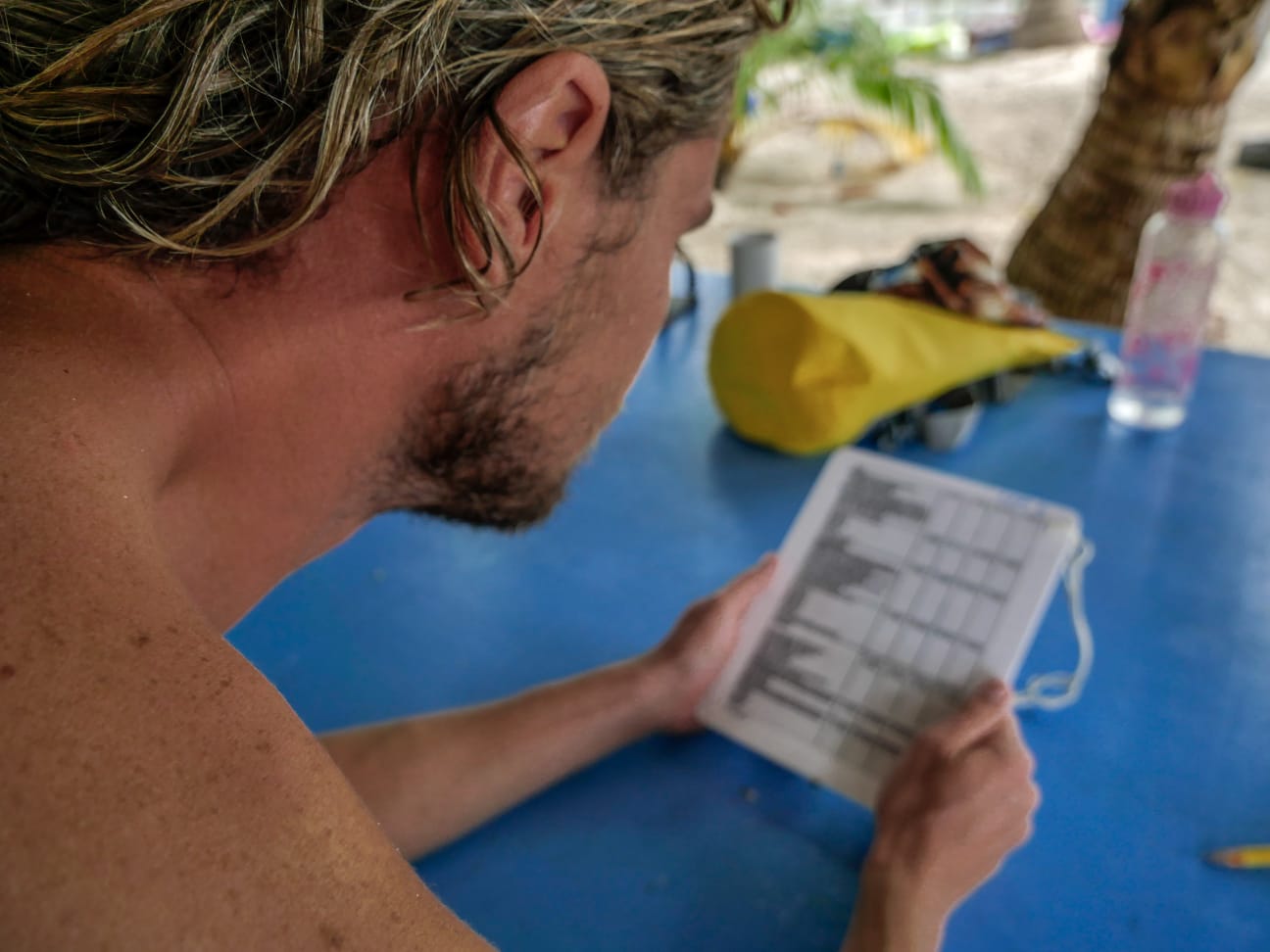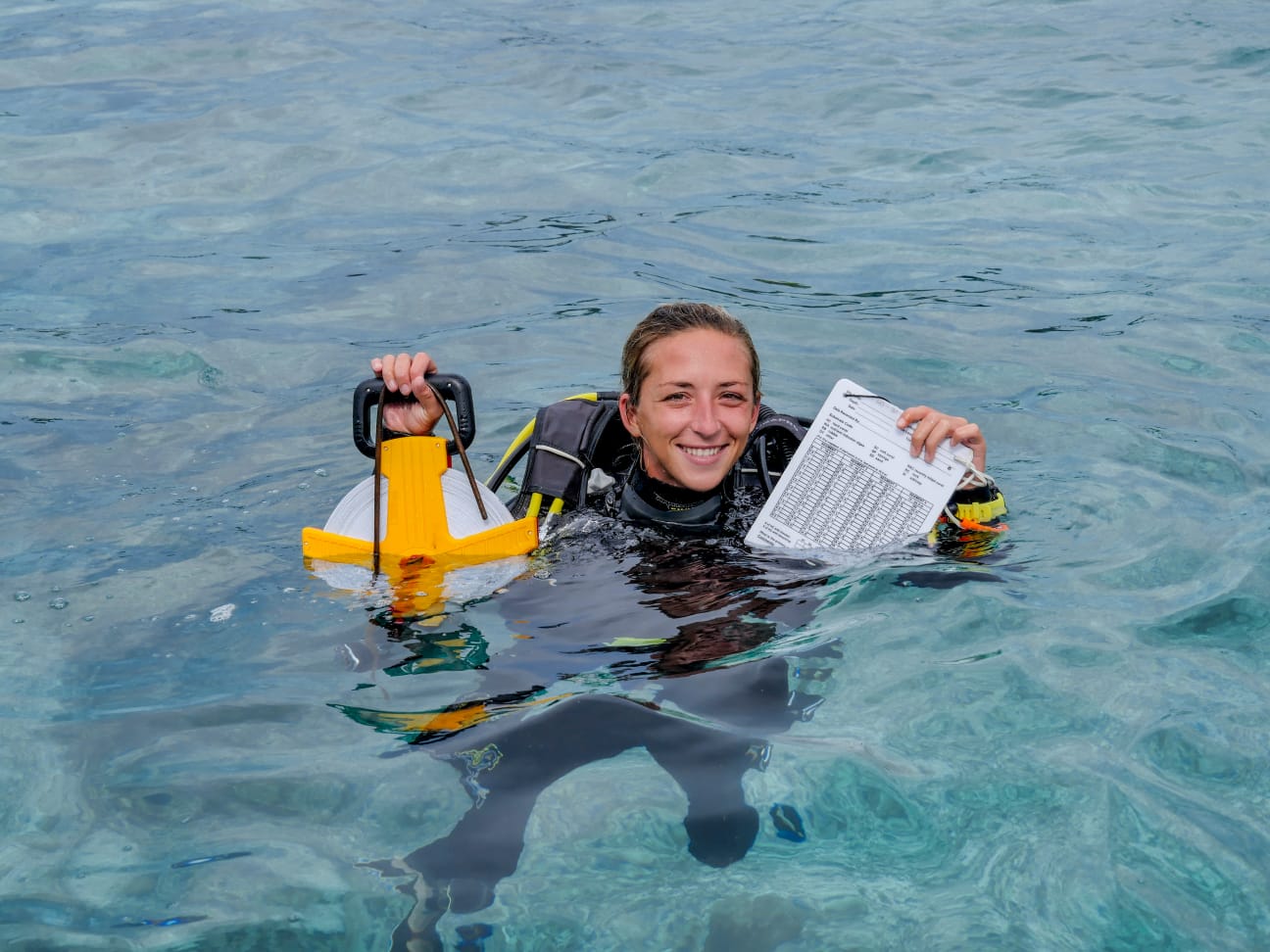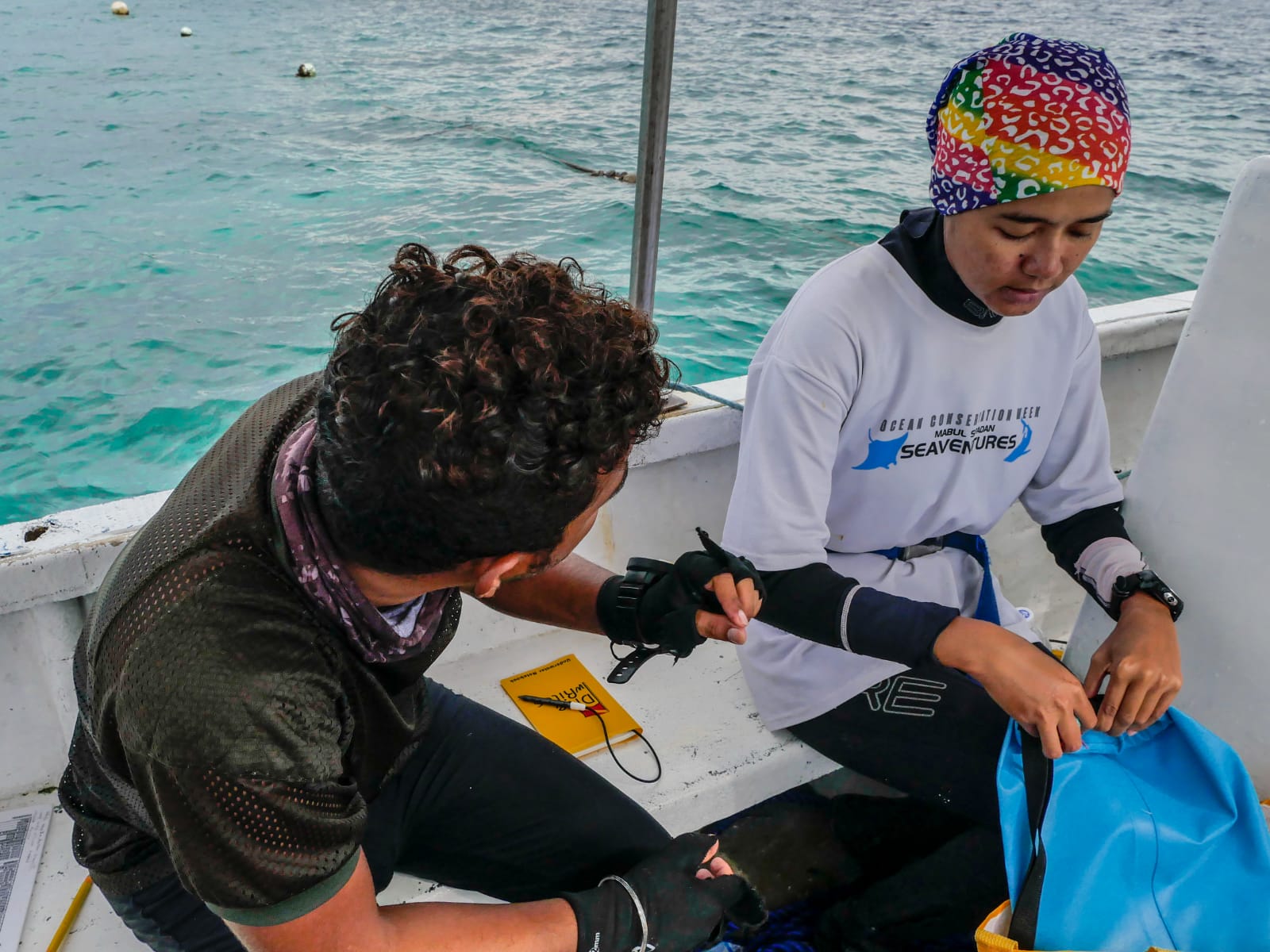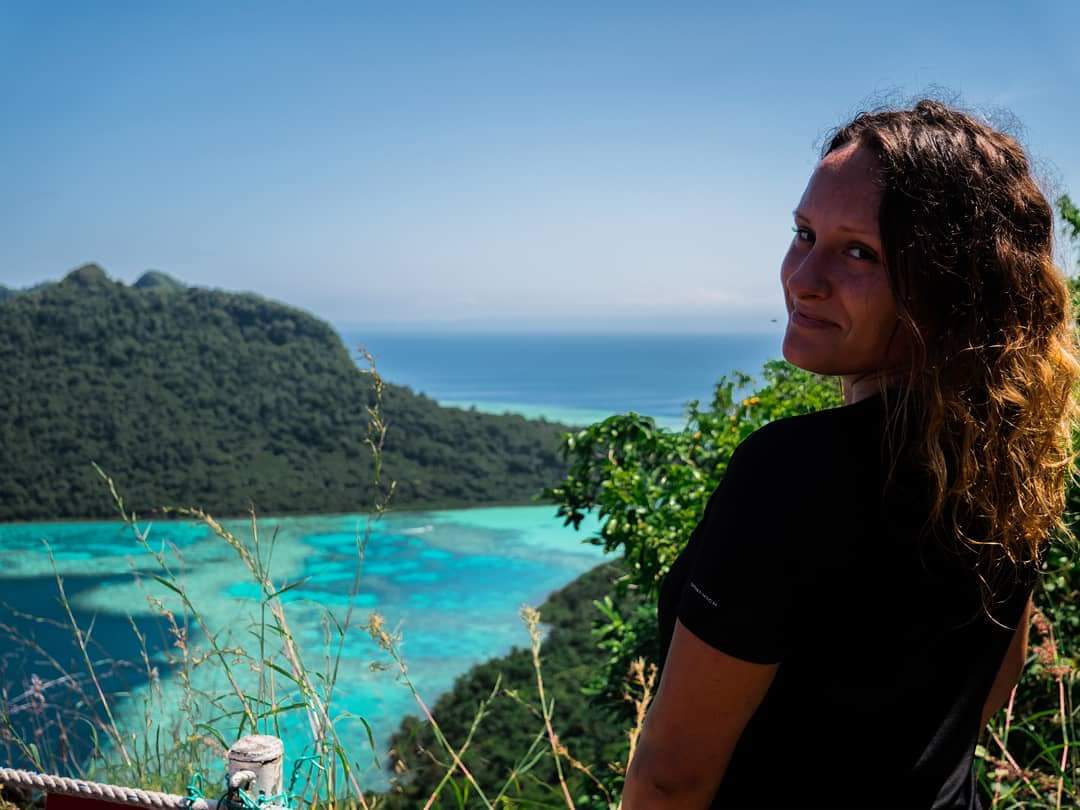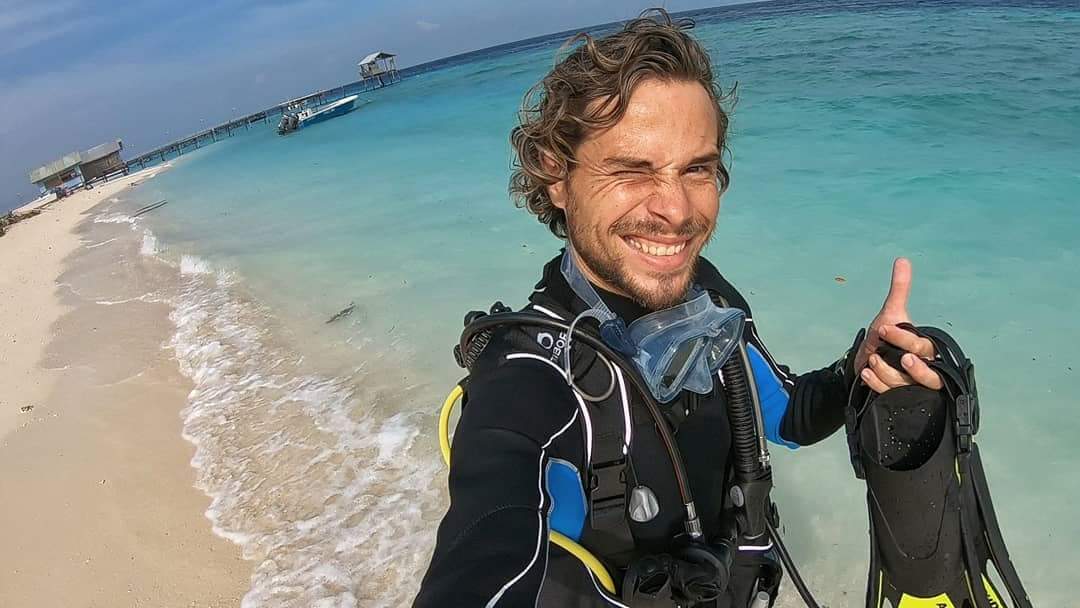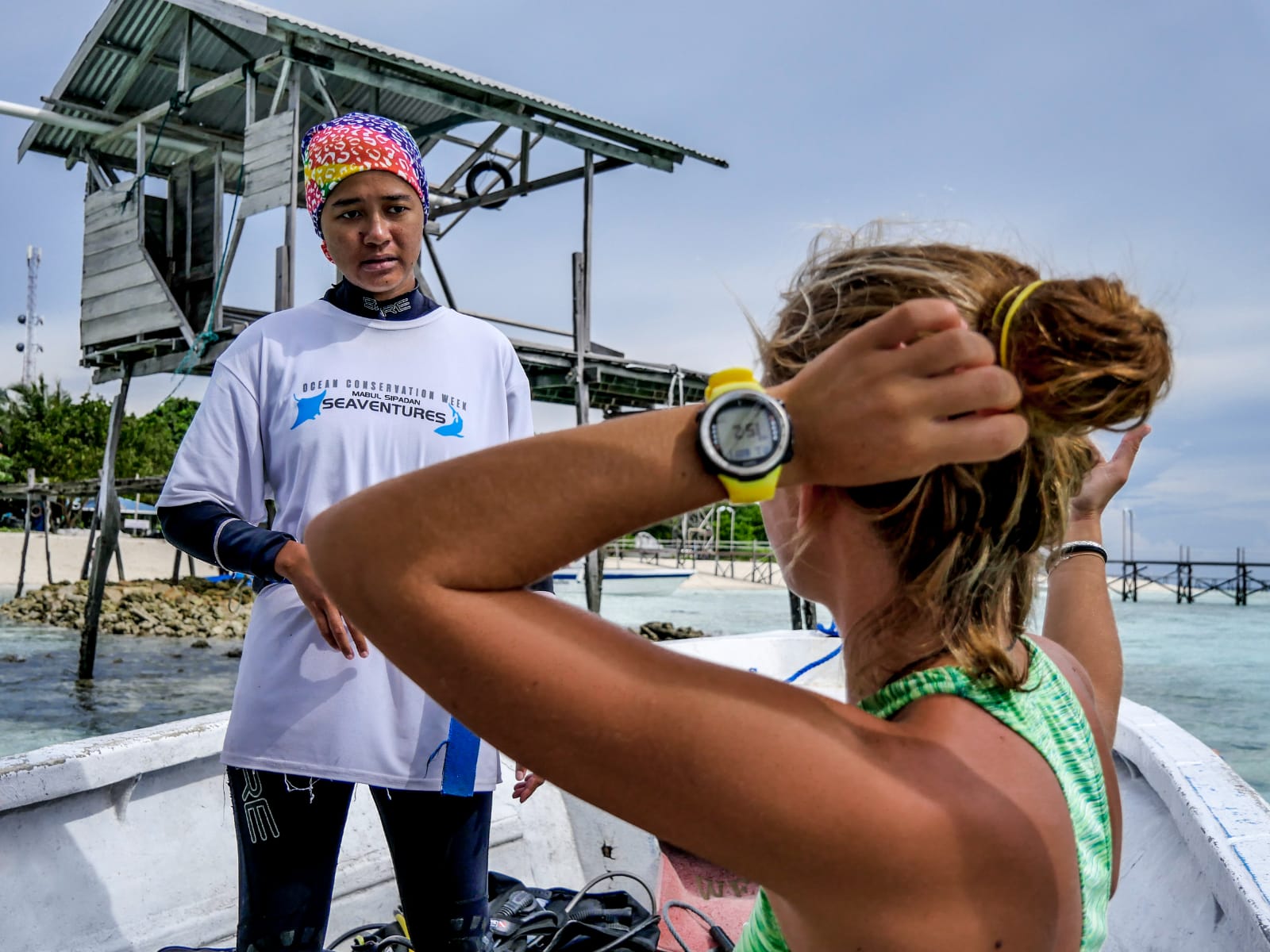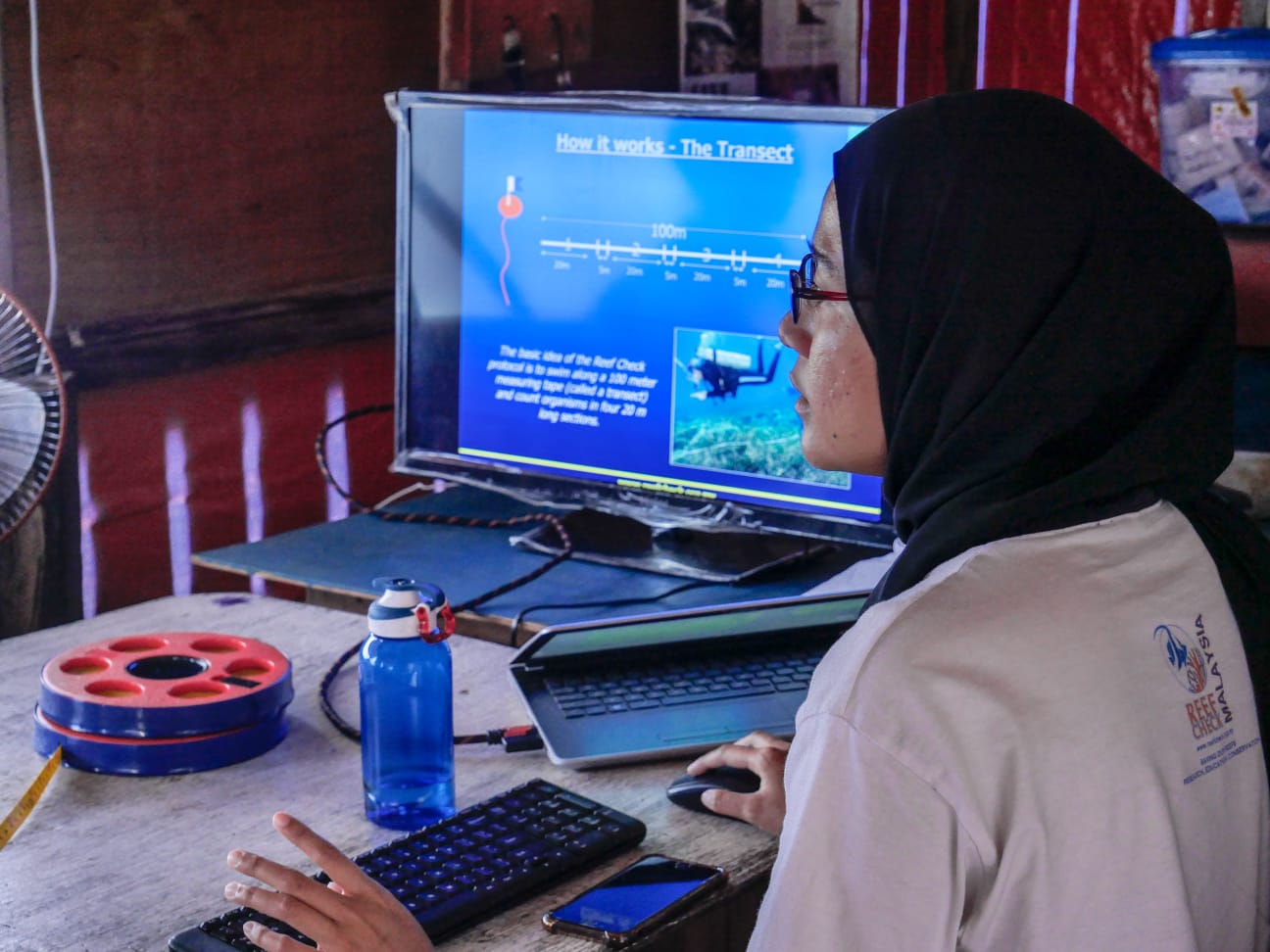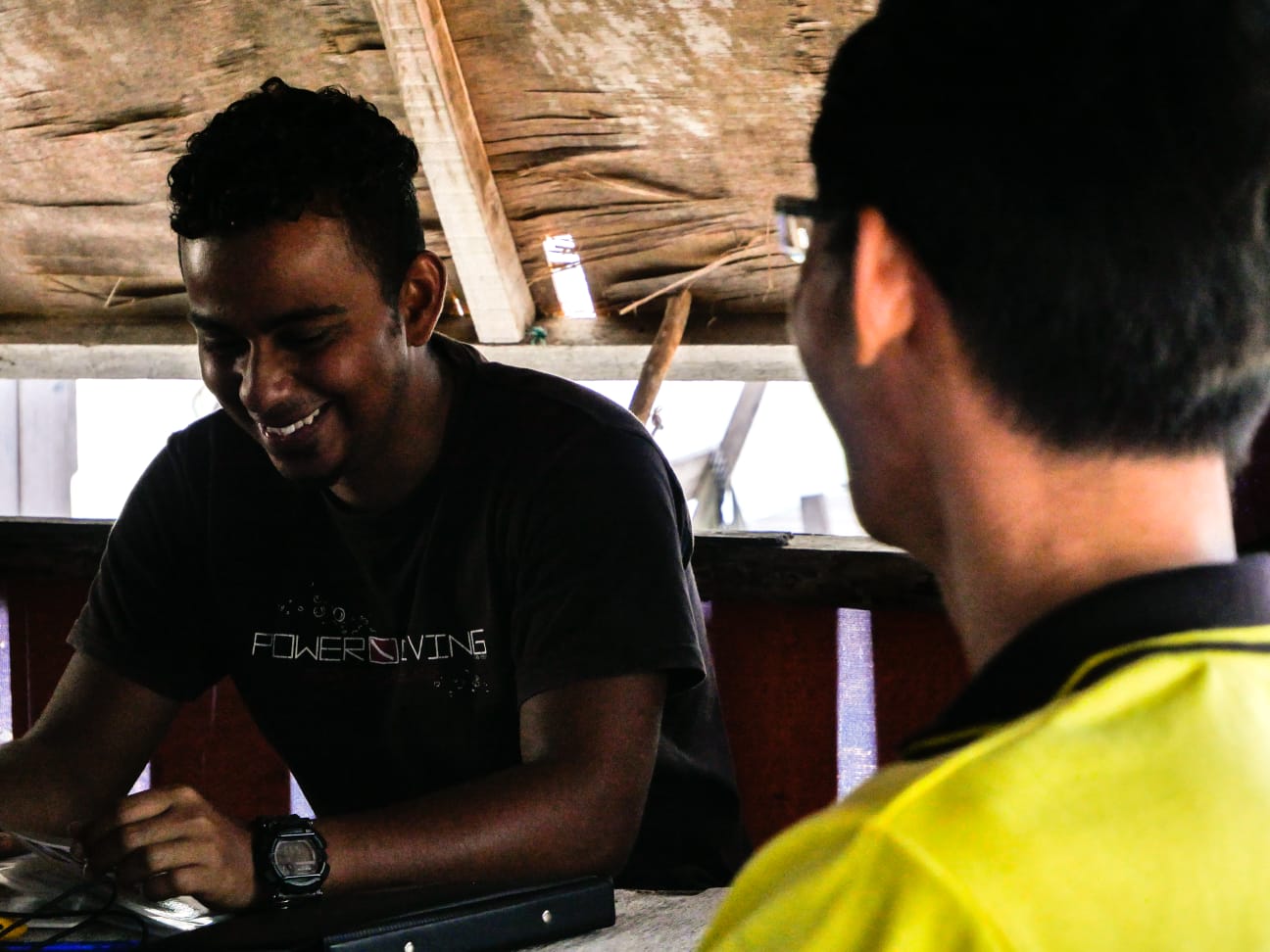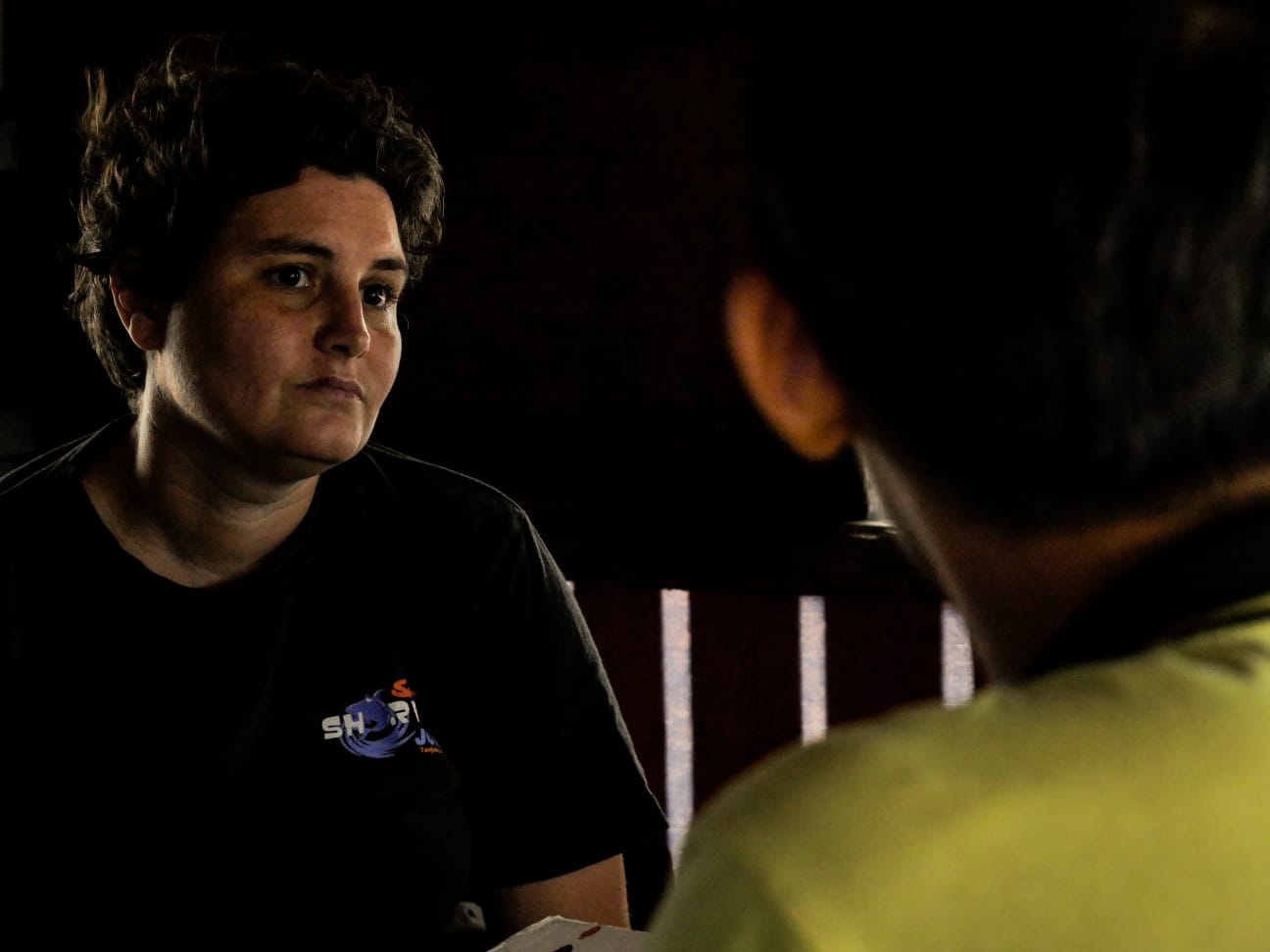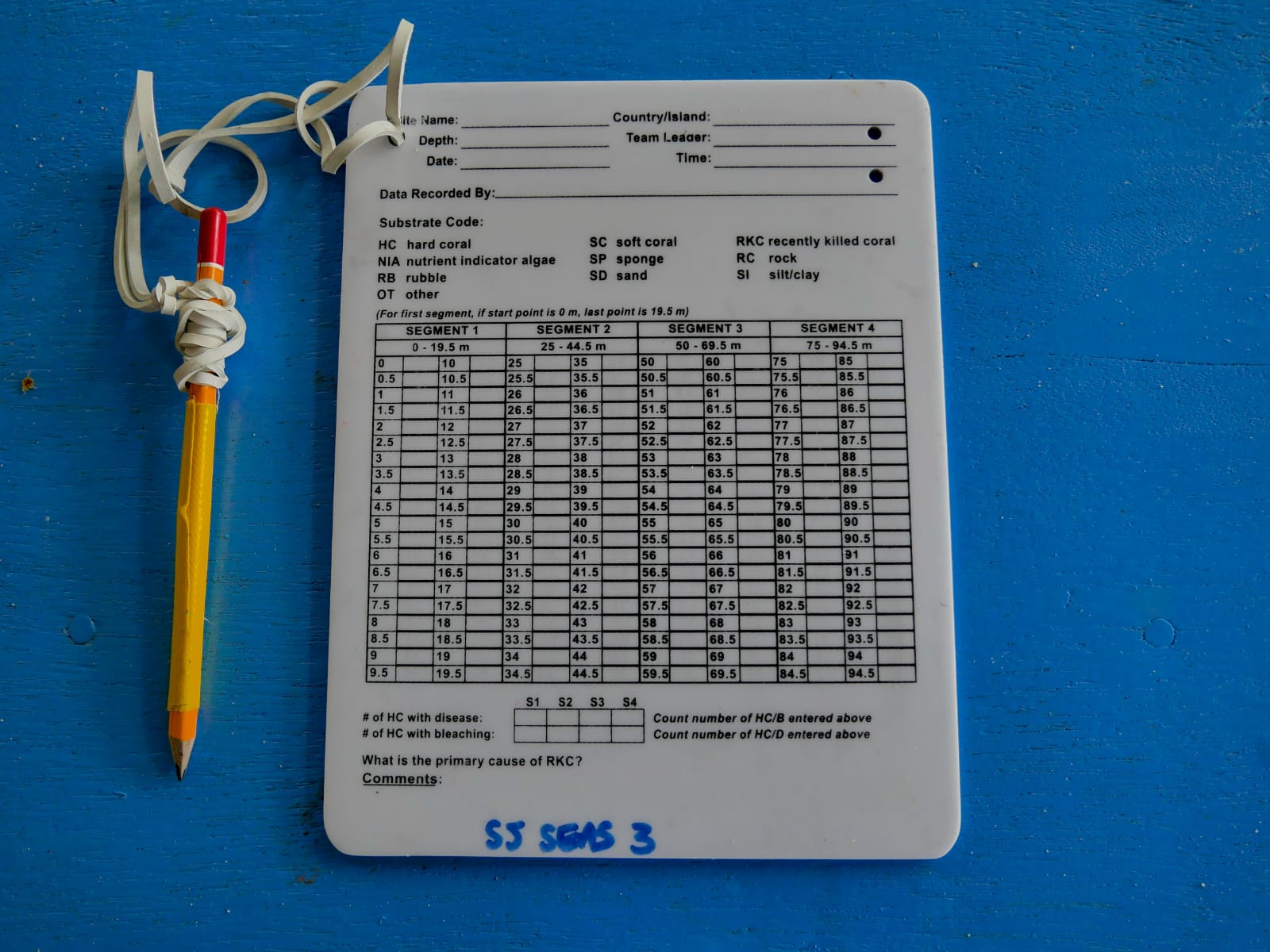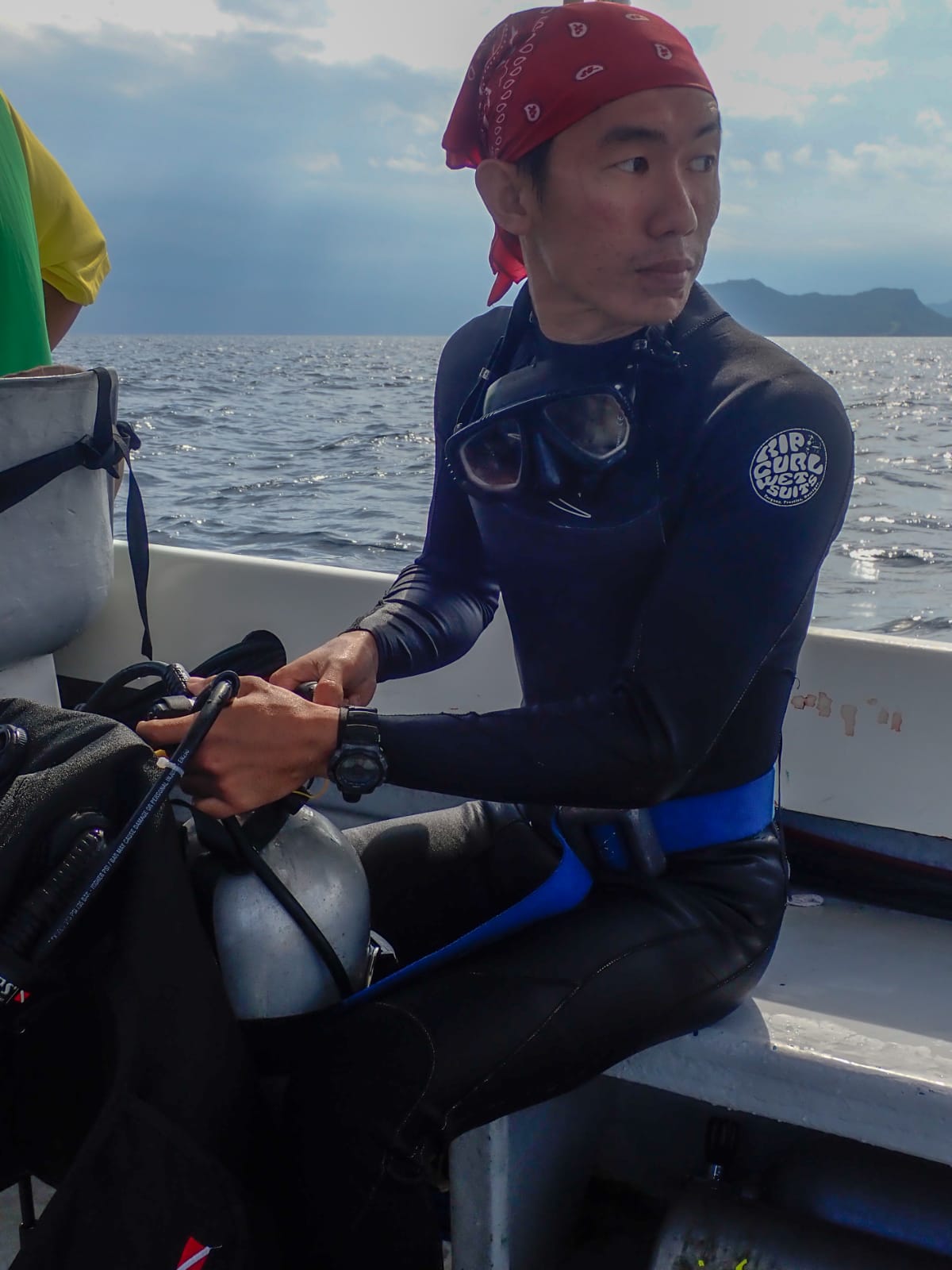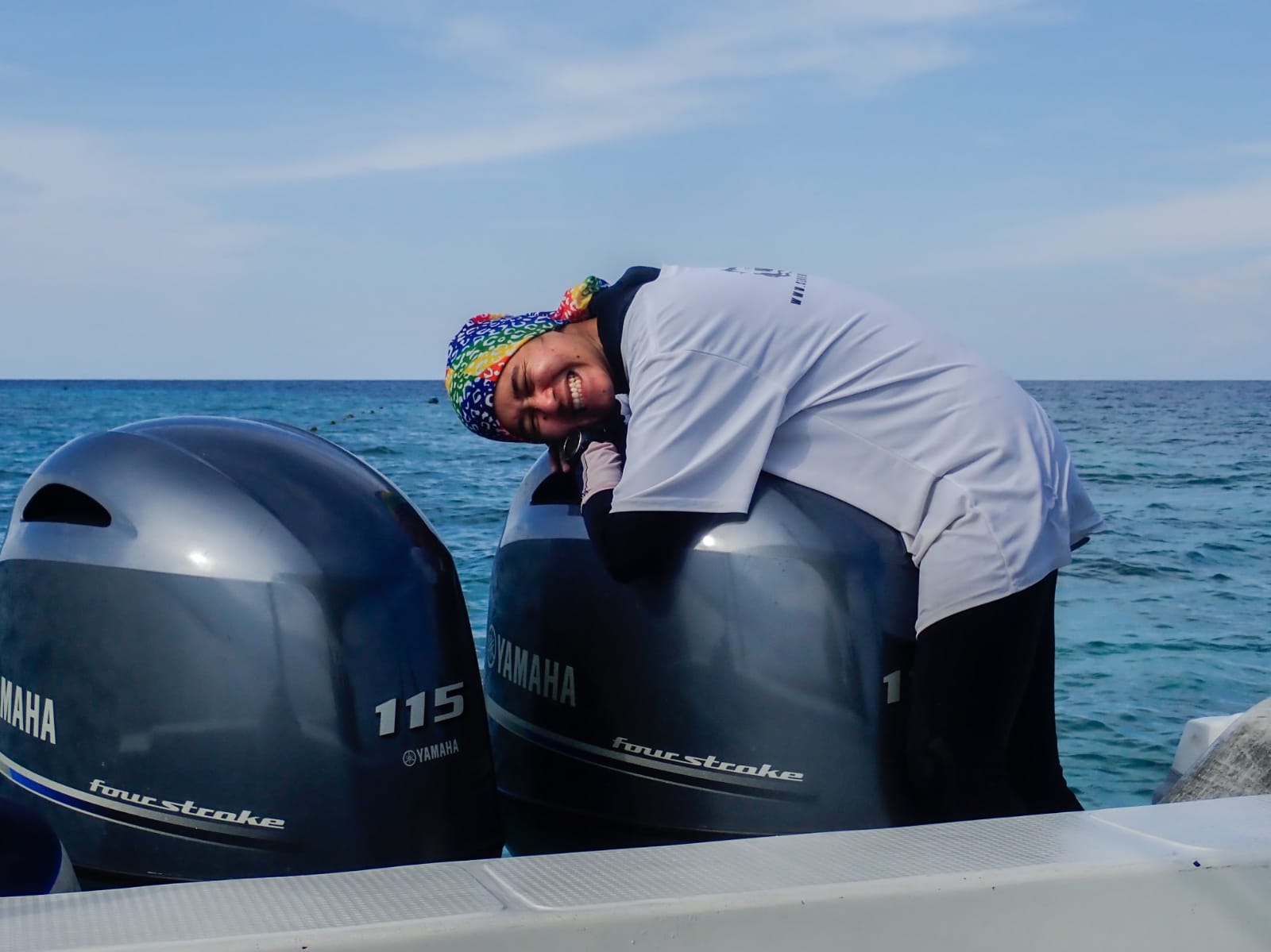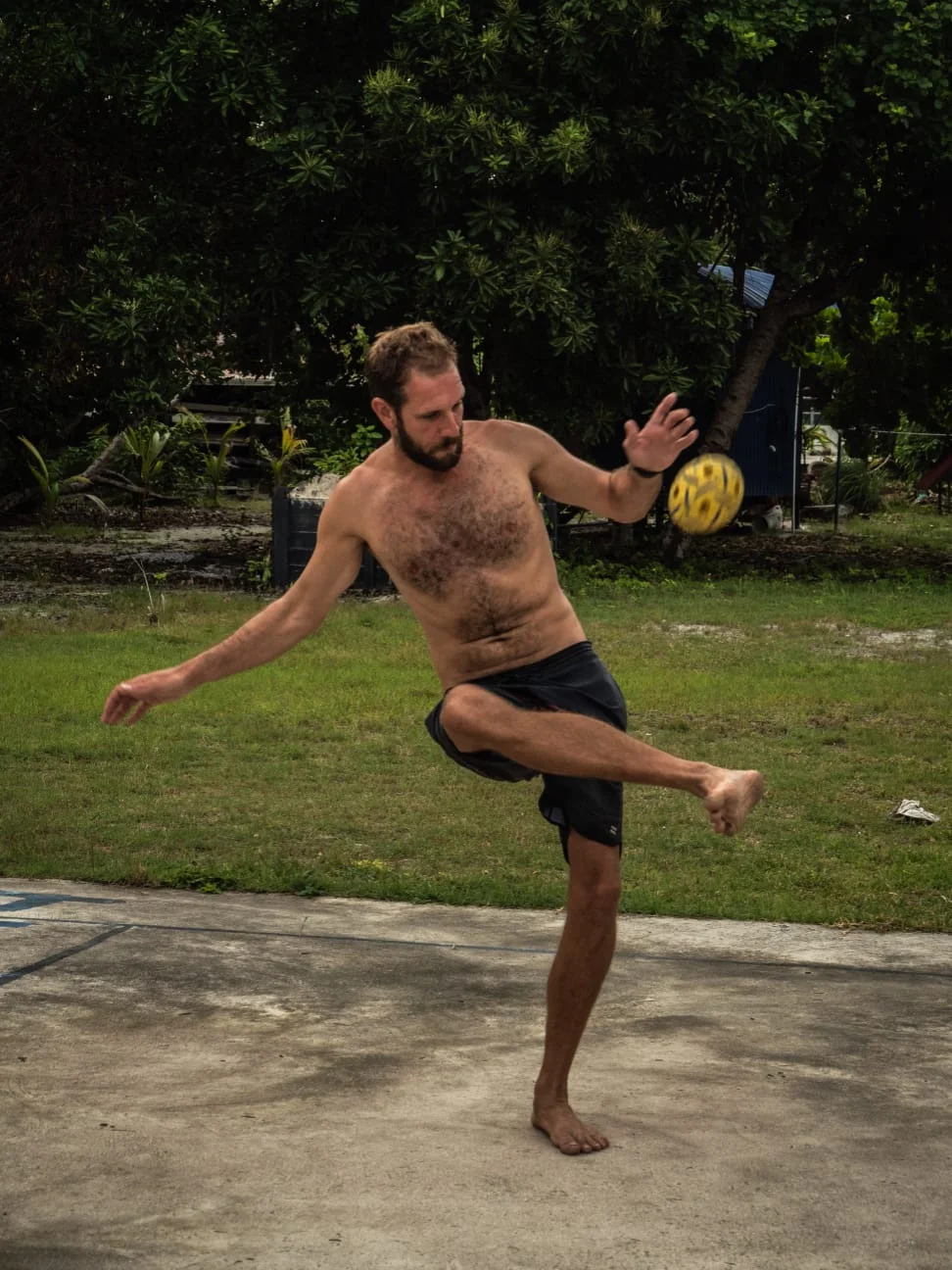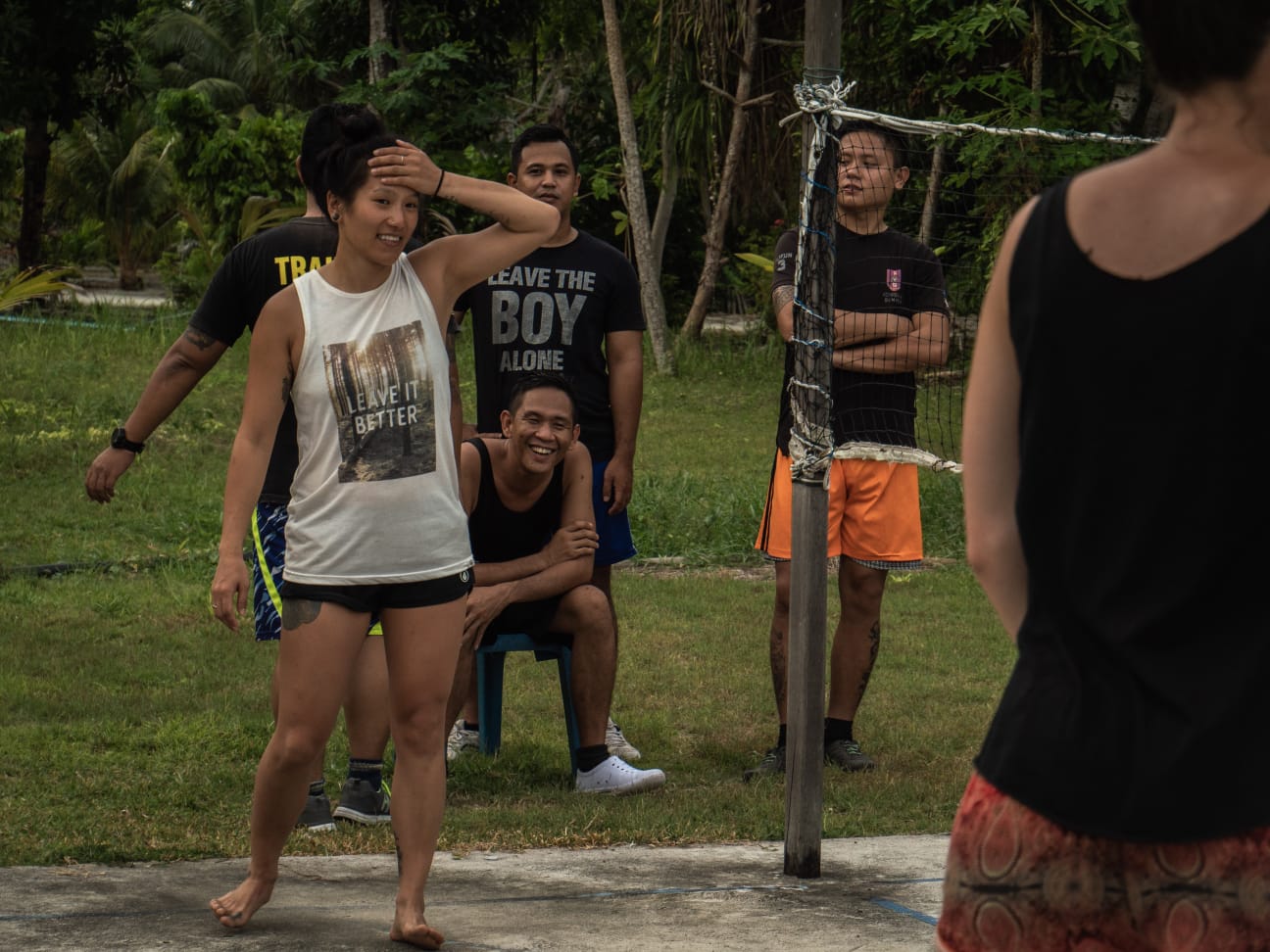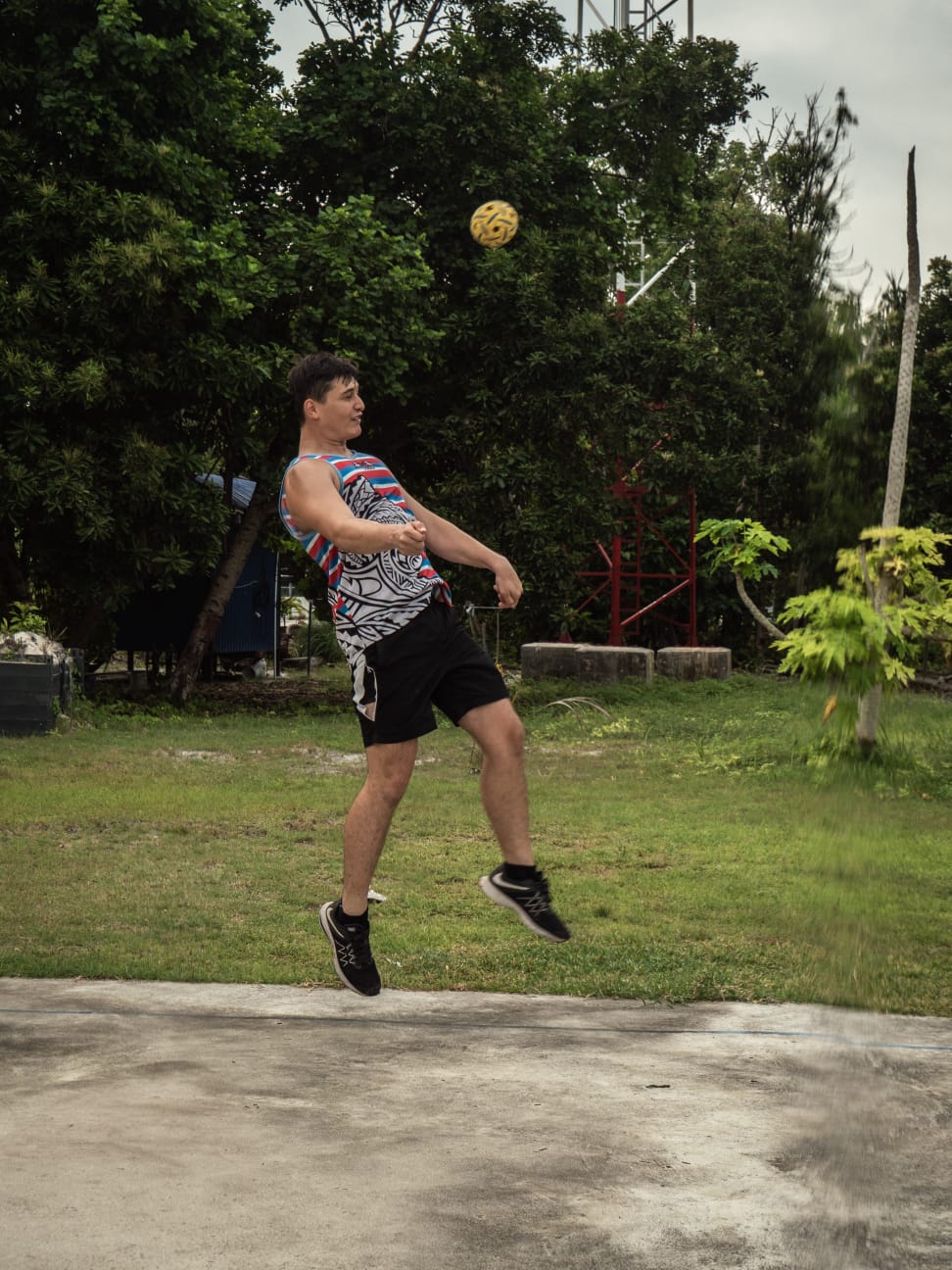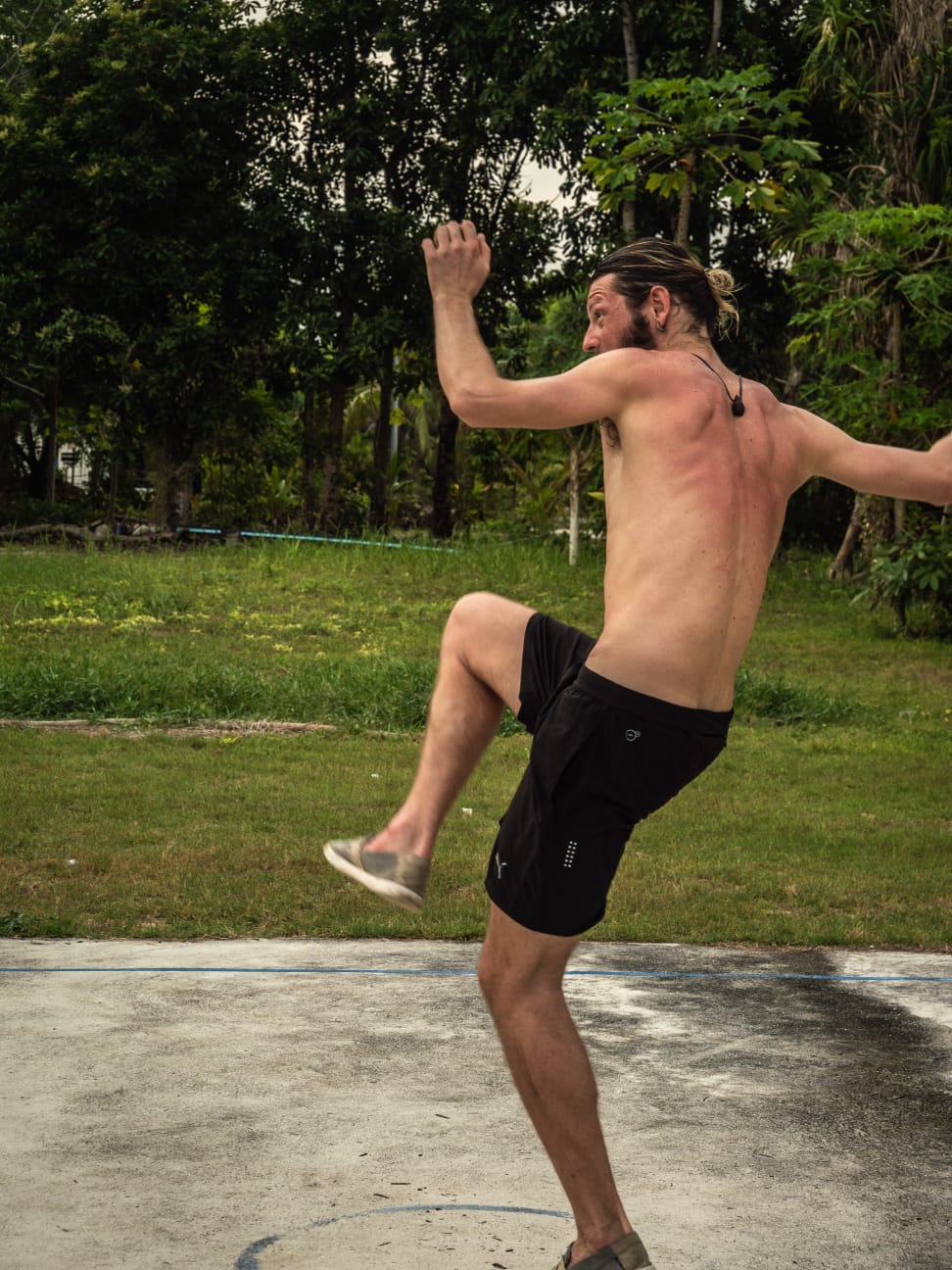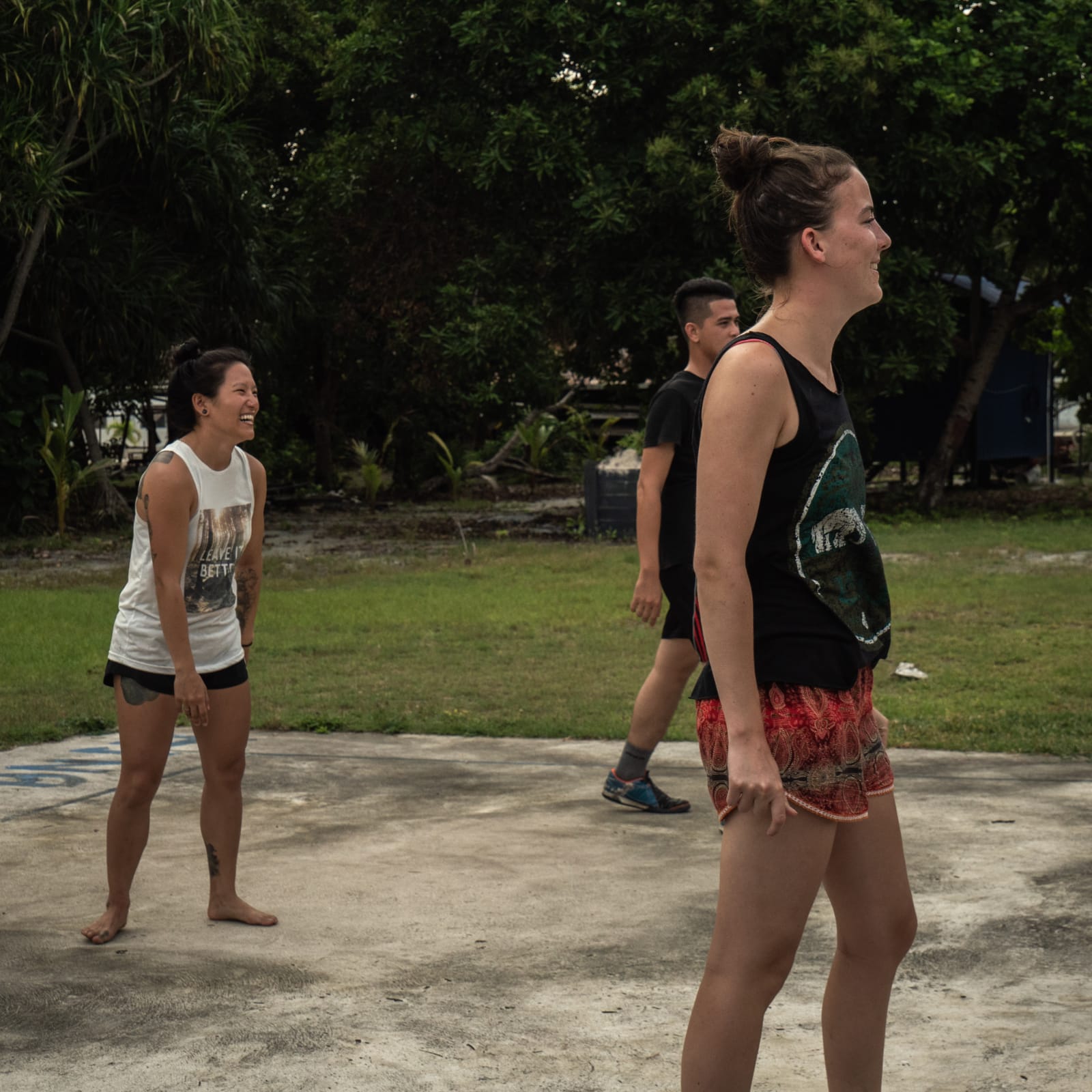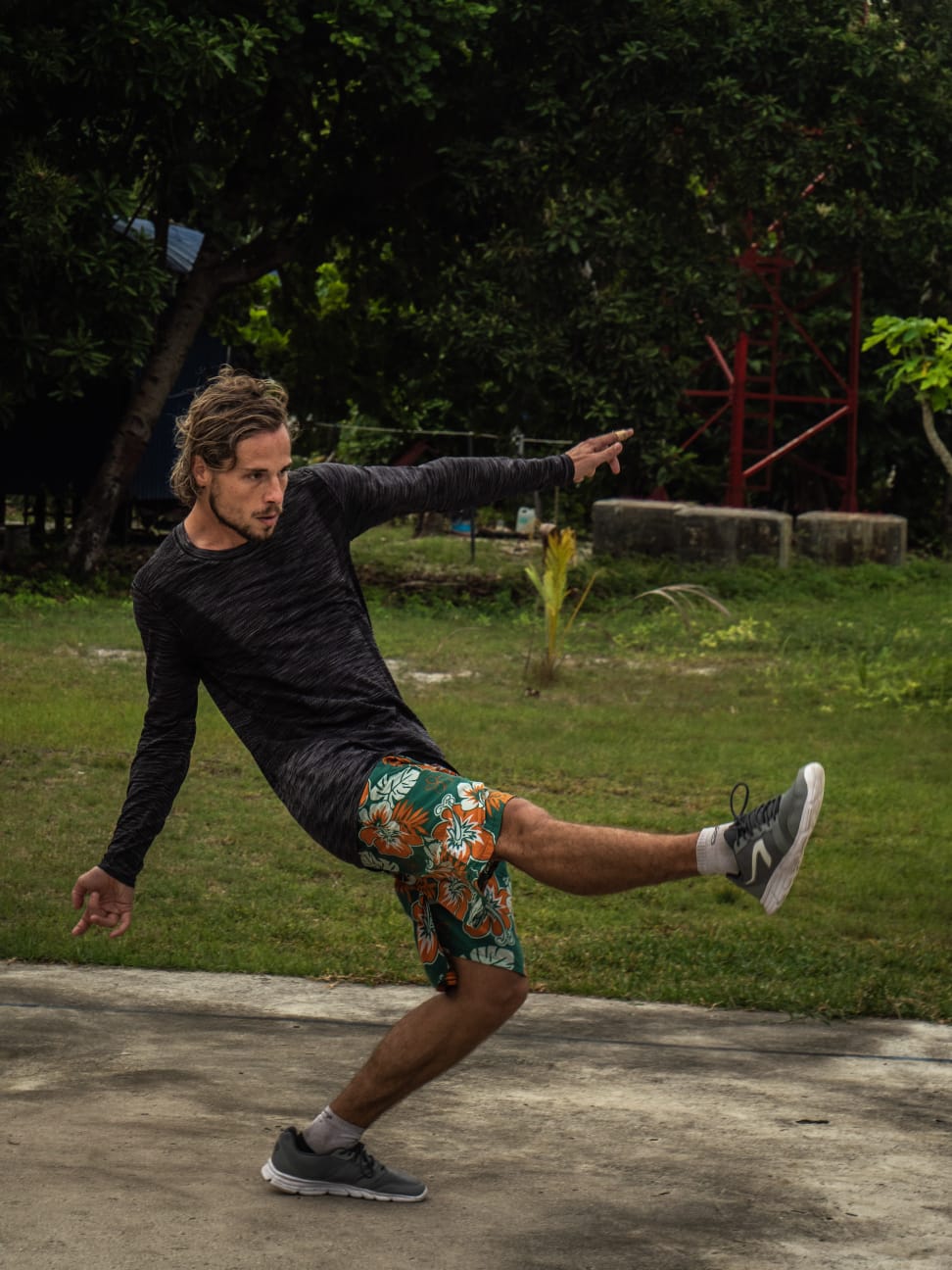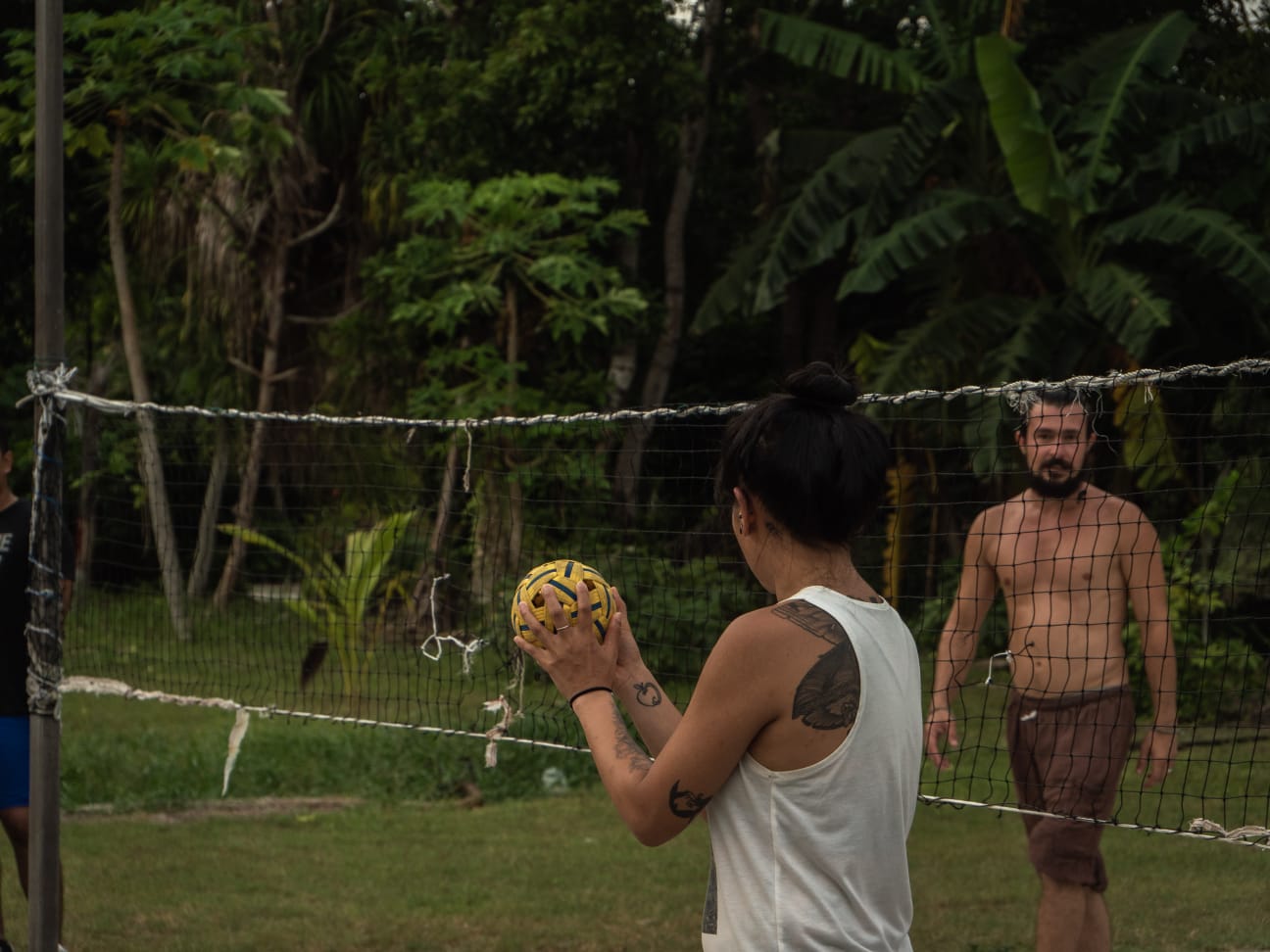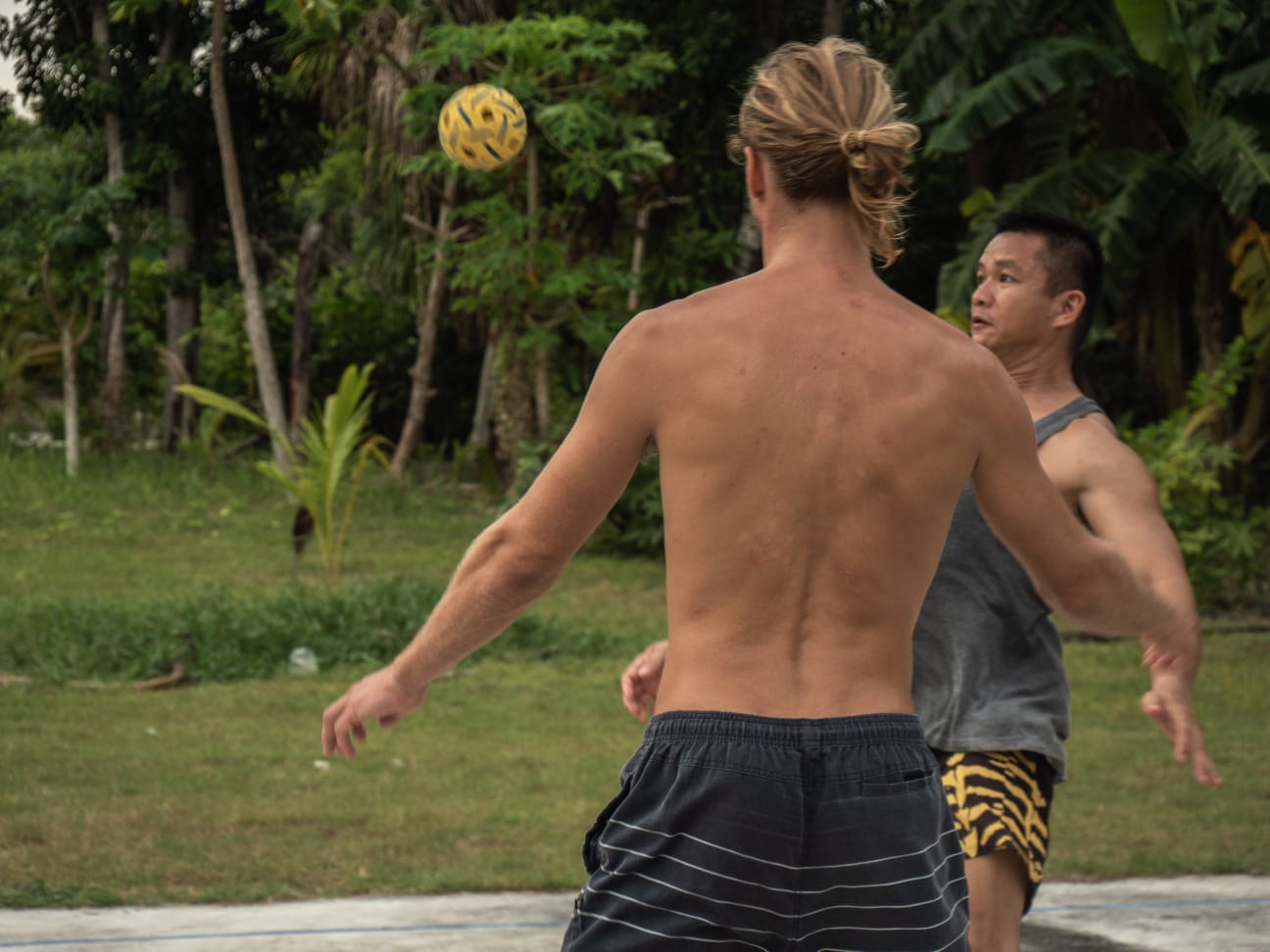MARINE SCIENCE A LEVEL COURSE: PLANKTON EXPERIMENT
Knowing how critical plankton is, and keeping conservation in mind, the A-levellers did some investigation into how we can view the kinds of plankton present in the waters surrounding Pom Pom.
What exactly is plankton anyway?
Plankton are the tiny plants and animals found floating in the ocean, they are some of the smallest and most abundant organisms across our planet. Plankton are the main food source for almost all fish larvae, feeding them until they grow into juveniles.
Plankton is not only critical for the growth of fish and other marine critters, it also sustains some much larger animals, like basking sharks, manta rays and blue whales who feed directly off plankton – they do this by filtering water and just taking in the small plankton from the water. With so many animals depending on plankton to grow, survive and thrive, plankton – both plant (phytoplankton) and animal (zooplankton) is vital to oceans – our tiny heroes.
Image by: David Palfrey
How do you study something so tiny?
Knowing how critical plankton is, and keeping conservation in mind, the A-levellers did some investigation into how we can view the kinds of plankton present in the waters surrounding Pom Pom.
To do this, we would need to collect a sample of these microscopic organisms, and look at them under a microscope. We decided to construct plankton nets, which are basically sieves you can drag along in the water that have very fine mesh to let water out but capture the plankton using materials that would otherwise go into landfill. We used old plastic bottles (that were collected from our daily beach cleans), very fine mesh and some ingenuity and constructed three nets. We used the same mesh and an old plastic oil bottle to make a sieve to make sure we had a good concentration of plankton to have a look at under the microscope.
After a biodiversity assessment dive, we hung our plankton nets off the side of the boat and cruised back to TRACC camp. Here, we emptied our samples into the sieve; put them on a petri dish, and looked at them under the microscope.
We had a great time looking at the samples and finding out what we saw.
What did they find?
Our sample showed up a lot of marine snow – which all the tiny floating bits in the ocean that come from almost every activities in the sea. We also saw dinoflagglets – which are unicellular phytoplankton, which are the most common type of plankton to see in tropical waters, and some copepods, which are the dominate zooplankton. Collecting and viewing these microscopic organisms is amazing, just knowing these tiny, nearly invisible organisms are the foundation for most of what we get to see every time we dive, and how every single element of the ocean plays a critical role in the environment.
Is plankton really so important?
While tiny, these organisms are vital to life on earth; phytoplankton is responsible for around half of all photosynthesis on earth – making them the largest carbon sink we have. By taking the carbon dioxide from the air and releasing oxygen, phytoplankton is a key in slowing global warming and keeping our atmosphere suitable for life. Because our oceans plankton are connected to regulating the earth’s climate, they are also being threatened by the rapid changes we are undergoing. Because of global warming, plankton, like corals, could be negatively impacted by increased exposure to the sun’s rays. Alongside the deleterious impacts of climate change, the increased pollutants in the ocean could be stopping some of the photosynthesis that these organism need to do in order to harness energy which they will transfer on to their consumer.
Image by: David Palfrey
While microscopic, plankton is critical for earths survival, and to protect it, we need to ensure adequate protection of our oceans and coastlines, and regulation of global emissions to make sure our oceans remain as beautiful and abundant as they should be – protecting life from plankton to whales and everything in between.
Written by: Maddie Davey
CROWN OF THORNS OUTBREAKS
How we are responsible and how we can effect change.
The world is a vampire. Exploitation of natural resources are on a very unsustainable scale as we are taking from our planet but fail to invest in it. There is no such thing as a free lunch and this is reflected in the devastation Earth has been facing from our actions. Human kind is oddly different in comparison to everything else except it. Our conscious thought has enabled greed to breed in us, making us seemingly unfit to live sustainably from the planet’s life.
It’s the conscience, however, that allows us to change who we are, good over bad creates the need to save our paradise. We must band together to fix our destruction, educating ourselves and spreading our love to other lifeforms. Like minded people create resilience in the face of adversity.
TRACC
Tropical Research And Conservation Centre (TRACC) in Sabah, Malaysia is one of many homes for these people. TRACC does everything and anything it can for the environment around it. TRACC does not invest but rather unconditionally gives. It creates a sense of belonging for people wanting to erase their carbon footprint and that of their fellow peers. Situated on Pom Pom Island, surrounded by the entire ocean, our workplace is also our paradise, and our work shows the hope we hold that Mother Nature won’t be destroyed, but rather saved by humanity.
Seamlessly time passes with each dawn and dusk making each day a contribution to the environment. Attending to global issues on a local scale such as turtle conservation, coral reef restoration, reef health monitoring and Crown-of-Thorns (CoTs) infestation are just a few to name from in the endless effort we place on our shoulders.
COTS
The Beginning
I would like to provide you with a detail discussion on one that has been a main focus at TRACC this year, CoTs Management Program.
It all started with a leisure dive to end the day well on January 2018 where an infestation of CoTs was observed on the northern tip of Pom Pom Island. Bear in mind, this island has been obliterated by blast fishing decades ago where the healthy coral cover now ranges in between 10-30% even at the best sites. Hence, we affirmatively made efforts to begin controlling the infestation by removing them from the reefs and burying them ashore.
The maximum number removed on a single dive by a five-person dive team was 85 CoTs. In the following month, we realised the need to establish the outbreak magnitude to understand the population demographics and dynamics. This was done simply by conducting a survey using the underwater belt transect with an area of 100 square meters. The results proved active outbreaks on all five sites surveyed for CoTs on the island’s reef. Little did we know back then, the infestation was much worse than we could ever imagine.
A Shocking Discovery
We started to look at neighbouring islands and reefs for the similar problem, specifically Kalapuan and Baturua. These reefs have been heavily exploited up until today as it is the main source of income for local Bajau Laut communities in the surrounding area. However, the areas are not commonly dived sites used by tourism, and are not within the state’s marine parks, meaning it has little exposure. Since we work closely with the local community in the area, we explore the reefs with them to identify infestation hotspots. That was when we had a shocking discovery of CoTs infestation that surpassed the outbreak threshold by a milestone.
Upon establishing that the spot outbreaks have passed the outbreak threshold on all sites, we began to physically remove them from the reefs we visited, whilst recording data for our long-term study. This includes the Catch Per Unit Effort (CPUE) where the number of divers for a given time were recorded to the number of CoTs removed. CPUE enables a relative comparison between islands and reefs, interestingly it showed the outbreak magnitude at Baturua is three-folds higher when compared to the Great Barrier Reef (GBR). A management program to tackle the outbreaks is essential especially when infestations such as this can further destroy an already damaged reef as observed very recently in a neighboring reef, Kapikan.
What Causes CoTs Outbreaks?
What could be the cause of these outbreaks? That is a dire question scientists are asking themselves. There are two hypothesis namely the nutrient hypothesis and predator removal hypothesis. It is more than clear that these sites are facing both threats combined where the reefs have been overfished and local communities have no waste disposal systems.
Reduction in predators like triggerfish, triton snail, humphead wrasse, could be an explanation to cyclic outbreaks where without natural predators CoTs can infest without a natural biological control.
On the other hand, influx in nutrients in adjacent bodies of water provides for algal blooms, which means the survivability of larval CoTs is greatly improved.
This would be catastrophic as a mature female CoTs can release more than 10 million eggs into the water column at once. That being said, an effective removal effort is needed to curb the infestation once and for all.
What We Are Doing
For the past six months, TRACC has been working tirelessly to study CoTs to provide for a better and more effective removal strategy. To achieve this, the gonad to body ratio of CoTs are being recorded to form a long-term trend on the reproductive cycle. The ratio can be determined by weighing the gonads and body of the CoTs where the presence of higher percent of gonads would show it is more fertile. This information allows for coordinated efforts throughout the region to remove CoTs before their reproductive peak. People from across the globe with various backgrounds come to this place making it happen through citizen science. This further builds to the understanding of the infestation dynamics and demographics as per the objective of the management program.
Friend Or Foe?
CoTs are definitely not the creatures they’ve been made out to be, as they play a vital role in keeping the balance of the coral reef ecosystem. This is achieved by them feeding on dominant and faster growing corals allowing space for the less dominant and slower growing corals to compete. They essentially promote the vital diversity of coral reefs. However during outbreaks, they tend to feed on multiple coral types including the slow growing and less dominant ones.
How Do You Know There’s An Outbreak?
Based on existing literatures, an outbreak can be classified when there are more than 40 CoTs per hectare of reef. These areas of spot outbreaks are undoubtedly facing a huge destruction based on the threshold. A single CoTs can feed a minimum estimate of 6 square meters of coral cover a year and 365 CoTs can feed on that area in a single day. On most sites of the management program, we have removed a rough estimate of 200-300 CoTs in two dives with just five experienced divers on the team.
The Results
This year alone, we have removed a total of 12,000 CoTs. This number could feed on around 180 square meters of coral every single day, which means we indirectly protect 18x10 meters of coral from permanent mortality in reefs that are already facing huge anthropocegenic threats every day. Knowing this, we are driven with high spirits to control such outbreaks while conducting researches to provide a clearer understanding on the population.
We foresee that through this program with the help of volunteers at TRACC, we can achieve The removal of CoTs on sites that have surpassed the outbreak threshold on a long-term scale. This would directly lessen the coral mortality in those areas and preventing large numbers of CoTs to affect adjacent reefs.
Pom Pom Island, is an evident observation that direct removal efforts can help in reducing the numbers of CoTs over a matter of time. Any CoTs Buster would tell you they’ve seen this with their own eyes. We have been in close contact with Sabah Parks for collaborations to manage the outbreaks as we understand the need for a regional effort to protect our reefs. This research would shed light on the dynamics of CoTs population where regional environment bodies can then strategize their removal efforts for maximum effectiveness. There are so many aspects to CoTs and we ,on a little island, are taking baby steps in order to answer questions that can help save the reefs of the Indo Pacific and beyond.
Written by: Jeeth Vendra
Shimah Kills You, I mean It.
Shimah had one of Tracc’s 2018 Industrial Training placements. She spent six months with us learning to dive, to restore the reef, to engage with the local community and to tackle the myriad issues facing our marine environment. Here, she recounts her experience in her own words.
Dive briefing with fellow reef builders
Dead turtles - possibly the smelliest thing known to man
Building ARC Units
Weighing marine debris after sorting
With the ARC unit’s underwater
Environmental Education Outreach
Shimah, staff and volunteers at Tracc
The past 6 months has been an eye opening for me, an ordinary aquaculture student who was wondering around applying for internship vacancy. I applied few places but Tropical Research and Conservation Centre (TRACC) is on top of my chart. It’’s a non - government organization who utilize volunteers, students and tourist in restoring the destroyed coral reef. I work hard, very hard in answering all the interview questions, it was pretty intensive I would say😅 I did not put high hope- That is why the moment I received the email of their acceptance, I valiantly attempt to calm down and gather my thoughts.
HOLY CRAP- I’M GOING TO TRACC !
It is a smooth journey upon arrival since they already explain everything to the smallest detail that I need to know. But even before I’ve got accepted to be part of TRACC, I have this negative hunch in my head “What if they don’t like me because I’m a muslim?” “Because I’m we hijab (head scarf)” “or simply because I am fat and ugly and not suited in diving field” LOL! SCRATCH THAT!!!! Everyone was very friendly- I mean everyone! The staff, the local Bajau staff, the volunteers even Moonson and Joey (loveeee them!) are very friendly, warm and welcoming. During my acclimatization period the staff help me a lot. I never feel lonely for they always checking up on me-in no time I already feel home. Thank you <3
Facility and food! The island life is soooo much better than what I have expected (from all the reading and interview questions). I know I’ll be staying in tent, but I DIDN’T KNOW MY TENT COME WITH A BED AND A FAN! I was so grateful that I was crying because I am physically and mentally prepared to sleep on the ground (for six months)😂. They also have a proper shower, toilet (with water pipe!!). The dive equipment also well managed, the whole 6 months of my stay I never have safety issue regarding my diving equipment that I borrowed from TRACC. Food is always served deliciously on time. Thank you Kak Neng :) I feel loved and life is so convenient at TRACC I would say compared to what I have been prepared and expecting.
I also earned my Advance Open Water diving license to the courtesy of TRACC as it is also included in their intern sponsorship. I check out with more than 130 dive after 6 months working there. Gotta say working dives helps a lot in practicing my buoyancy. I love doing my working dives!! It feel so rewarding after you did something for the ocean :)
I also learned a lot of new knowledge while staying at TRACC such as fish id, coral form id and invertebrate id. What I like about TRACC is they don’t simply do something without knowing why- This goes to my science director, science officer and camp manager. I like how all the conservation activity is monitored and recorded -before, on going and after the restoration activity. I also learn good working ethics while working with different background of people there, not only it broaden my perspective but I also learn to to look from different view and most important thing is, I learn to live in more sustainable way. NO STRAW. REDUCE, REUSE, RECYCLE!
It is so thoughtful of TRACC for willing to spend money on Malaysian internship program. I think this is a very good way to spread the marine conservation awareness among Malaysian. For instance me myself did not come from the marine background, so thus my friend, when I posted pictures about all the conservation project I did at TRACC it is always become the talk of my friends, they always been curious but never exposed to the marine conservation project- I explained to them and they started to understand fir instance not using plastic straws is not just a trend nowadays but also for a good course, I hope I did my part well.
Its safe to say life at TRACC is the highlighted part of my life. I wished that there were another word that held more weight than " thank you" because I would have used it for this opportunity of a lifetime
Rock Stars
Shimah’s presentation on her time at Tracc is available on our GoogleDrive here. To apply for a sponsored Malaysian internship or to join us as a volunteer please submit a contact form here.
REEF CHECK TRAINING!
We have some exciting news… TRACC is now able to train volunteers on Reef Check surveys, enabling them to have a certification from Reef Check, and be Eco Divers! This is very exciting for us, as we’ll be able to add to a global image of the state of the world’s reefs, as well helping us to track the impact of our own restoration projects on Pom Pom.
We have some exciting news… TRACC is now able to train volunteers on Reef Check surveys, enabling them to have a certification from Reef Check, and be Eco Divers! This is very exciting for us, as we’ll be able to add to a global image of the state of the world’s reefs, as well helping us to track the impact of our own restoration projects on Pom Pom.
So what is Reef Check?
Reef Check Malaysia is part of the world wide Reef Check network. Established in 1997 in the USA, Reef Check was founded by a group of scientists who developed a simple, rapid method of surveying coral reefs. Reef Check Malaysia (RCM) has established an annual survey programme to assess the health of coral reefs around Malaysia.
In the last eleven years RCM has trained over 800 divers to conduct reef surveys at over 150 permanent monitoring sites on coral reefs at different sites around East and Peninsular Malaysia.
The survey sites around Sabah, 2017.
So what’s it all about?
Reef Check surveys are based on the philosophy of “Indicator Species”.
These are marine organisms that:
· are widely distributed on coral reefs
· are easy for non-scientists to identify
· provide information about the health of a coral reef
The species that our Reef Check divers look for are shown in the picture of the survey slate below:
As you can see, there are several different fish and invertebrates that our Reef Check divers need to be able to identify! Not to worry, we have some amazing Reef Check trainers at camp, who will teach you how to identify each individual species, and you’ll have the chance to do a “mock survey” to make sure you’re confident in your ID skills before going on your first Reef Check survey!
Using a standardized methodology, data from surveys in different sites can be compared over time, whether it be on an island or international basis. By surveying reefs on a regular basis, changes can be highlighted early before they become problems. This gives us the opportunity to intervene to try to reverse the change before permanent damage is done to the reef. The figure below shows the basic methodology that our Reef Check divers follow:
First steps at TRACC
We had the opportunity recently to have 3 lucky members of staff take part in Reef Check Trainer training- this would allow them to teach volunteers how to carry out underwater surveys on our island.
Once they were trained and ready to go, the first three students were picked to gain their Reef Check certification! They were Taylor; one of our amazing instructors, and Anaïs and Loïc; two fantastic long-term volunteers and two of our ARC Reef Masters.
The training consisted of a few lectures to give the background to Reef Check, and teach about the different aspects that the surveys look for:
· Fish species
· Invertebrate species
· Different substrates
· Reef Check method & impacts
After the lectures, they were taken out on “pointy dives”, where each item that is on the survey is found and pointed out, so that everyone has a clearer understanding of what they’re looking for, and given an idea of where the species can be found.
They were also taken on a mock survey dive, to get in some practice before a real Reef Check survey, and to reinforce the methods they had learnt over the past few days.
After their training was complete and they were certified (hooray!), I asked them some questions about their experience:
Q: What is your background in science? How did you find the scientific side of the training?
T: I have a degree in Environmental Science, with an emphasis on conservation biology. So as much as I have a strong background in science, I did learn things too; for example, identifying the different types of substrates was harder than expected.
A: I quit science when I was 17 and choose to specialise in business and marketing. So I found the lectures to be intense. Fortunately, we have been practicing our fish and invertebrate ID skills the last 3 months at TRACC! But the substrates lecture was for me was also the most challenging one.
L: I am an engineer, so I do have a science background, even if it is far from marine biology! I really enjoyed the class and found it challenging.
Q: What did you think of the whole experience? What was your favourite part?
A: The whole experience with our instructors was amazing, we are truly happy and grateful to now be able to collect data for Reef Check.
L: The best part was carrying out the survey. It is very different from any diving we have done before. As an eco diver, you need to have specifics skills like identification or the capacity to stay focused and be able to record data even if you are upside down! I am sure that the training will help me to become a better and more aware diver. Besides, it was fascinating to learn why we count some species and not others; understanding what they reflect and what their absence or presence on a site means.
Q: Who would you recommend Reef Check training to?
A: The training can be completed by anyone. I don’t have a science background and I still was able to be certified. But be prepared! The training is intense for non science people!
You don't need to have a certain number of dives to start your eco diver training, but you still need to have a really good command of your buoyancy. So as soon as you think you have the diving skills required, go for it and if you are not sure ask your divemaster or instructor. They can also help you to improve your diving skills.
L: Also, you need to enjoy looking for things like invertebrates, because that's what you will be doing in the surveys!
Q: What will you do now that you’re an eco diver and Reef Check certified?
A & L: We will first participate in the surveys here at TRACC. And once we’ve moved on, we want to help other Reef Check Dive centres and take part in their surveys too. When you are a Reef Check Eco diver, you can join any survey in the Indo Pacific! To find opportunities, you just need to check their website… there are plenty! But first, we will spread the message among our families and friends.
Here at TRACC, we are so excited for this new opportunity for our volunteers; helping them to improve their ID skills, their buoyancy, and most importantly, helping a global community to monitor the world’s precious reefs!
We also want to thank Reef Check Malaysia and our wonderful Instructor Trainer Nadhirah for this amazing opportunity!!!
Words by: Helena French
Images by: Anais Lafuente
TAKRAW MATCH!
We had wanted to visit the police to build more of a relationship with them, and the easiest way to do this when there’s a language barrier is to play a sport- especially when one side is awful and can be laughed at by everyone!
Takraw
Words by: Helena French
Recently, some of our volunteers took off on an adventure across the island to the police station at the Big Pom Pom resort. We had wanted to visit the police to build more of a relationship with them, and the easiest way to do this when there’s a language barrier is to play a sport- especially when one side is awful and can be laughed at by everyone!
Photo by Anais Lafuente
We decided to try our luck at a game of takraw- which is basically a modified version of volleyball played with your feet. Different versions of the game are taught all across Asia, with it being taught in PE in school in Malaysia and is often played between friends. Therefore, the police officers we challenged were incredible at the game… something we discovered about 10 seconds into watching them warm up!
Photo by: Anais Lafuente
What is takraw?
Like myself, the majority of our volunteers hadn’t played or even heard of Takraw before, so after speaking to our Malaysian science officer Jeeth, and some (a lot of) googling, we felt like we were ready to give it a go.
The basic ideas of the game are:
- · The ball is light and small, about the size of a grapefruit
- · The courts are smaller than the size of a volleyball court- about the size of a badminton court
- · 3 people play on each side, in a triangle formation.
- · The rules are similar to volleyball, the difference being you can’t use your hands. You can use your legs, feet, chest, head… as long as it’s not your hands, you can use it!
- · You can only have 3 passes each side like in volleyball, but in takraw one person can hit the ball 3 times, rather than needing to pass it between hits.
After watching the police play for a few minutes, we decided it was our time to shine!
Photo by Anais Lafuente
As you can see from the pictures, our volunteers gave it their best shot- with varying levels of success!
We had to head back to camp after an hour or so of playing to help unload our boat of groceries and new volunteers, which suited us just fine, I think we’d underestimated how difficult the sport can be in the afternoon heat and with so many expert eyes watching us!
It was a great way to bond with the police that protect both the island and us, we’re hoping that we can play a game with each new rotation of officers- about once every two months. That will give us time to prepare for the next game, as it was universally decided that we need the practice!
Photo by Anais Lafuente
In return, we will continue to take the officers diving on our house reef, showing them the work that we do, and spreading the conservation message. This is clearly working so far, as when Jeeth visited a local conservation centre on Mabul, one of the police officers recognised him as a turtle walker on Pom Pom!
On a Blood Shortage Mission: Marine Conservationists to the Rescue
“Guys an emergency has occurred to one of TRACC’s loyal friends, his name is Zainal, his Mum has lost a lot of blood. The hospital is unwilling to use their low reserve on a local Bajau old lady with no nationality, but they are willing to do a blood exchange”
Words and Pictures by Elizabeth Fitt
“Guys an emergency has occurred to one of TRACC’s loyal friends, his name is Zainal, his Mum has lost a lot of blood. The hospital is unwilling to use their low reserve on a local Bajau old lady with no nationality, but they are willing to do a blood exchange”
It’s 00:40 on a tiny Island in the Coral Triangle when the WhatsApp message comes through, sent to all at The Tropical Research And Conservation Centre (TRACC). It’s from Kit Wui Sien, 24, Science Officer on the board of directors at TRACC. and he’s mobilising a group of Marine Conservationists to volunteer in a way they were certainly not expecting when they decided to come to TRACC to study Marine Science, carry out research, and rebuild coral reefs. “I’m going to donate as much blood as I can at Semporna Hospital. Is there anybody that would like to join me in some blood donating activities tomorrow?” he asks.
Norabil Jinti Jaiman had been enjoying a visit from her son, Zainal, at her home on Kalapuan Island on Monday, when she lost consciousness. “I was supposed to bring back my new boat to Semporna, but ended up bringing my Mom” said Zainal, who has IC and lives in the small coastal town of Semporna. “I couldn’t bring her straight to the hospital because she doesn’t have the proper documents. So I brought her to a private clinic. The Doctor told me she needs serious care and helped me to write a letter to the government hospital so that I could take her there” he explained. The hospital went on to tell Zainal that his mother needed a minimum of four pints of blood and that, because of a blood shortage, this would not be possible unless he could find people to donate this for her.
By morning the TRACC WhatsApp group was inundated by a flood of willing volunteers and breakfast conversation was dominated by the subject. Those deemed most likely to pass the hospital’s screening questionnaire were loaded into the organisation’s boat to begin the 30km voyage to the mainland. Five of Malaysian nationality, one British person who’s lived in Malaysia all his life, an American type O- included in case the hospital was willing to take blood from non nationals as a last resort and a second British person who just really really wanted to try to help.
Semporna Hospital is small and though slightly run down, the grounds look nicely kept and the staff are very helpful. After a short wait for the lunch break to finish the Marine Conservationists are ushered into the Phlebotomy Unit. Nurul Adira, 25 is the Medical Laboratory Technician in charge today. She takes obvious pride in her work, efficiently supervising the Marine Conservationists through blood type tests and screening questionnaires. “We always have a shortage of blood” she says ruefully. “We need family members to replace blood if their family member needs a transfusion. It’s because this is a small hospital in a district where a lot of people have no IC documentation and we can’t take blood from them so there are not enough donors. For Bajau Laut people no blood replacement is possible without it being from their family.”
Jaiman is Bajau Laut and is stateless – with no legal access to state medical care. Without blood donors coming to the hospital to give blood for her, she would not be able to have the blood transfusion she desperately needed when she lost consciousness because her blood haemoglobin levels dropped to 3.8 (they should be around 10 or 11 in a healthy human). For hospital staff this is very difficult, Adira says she feels terribly guilty when patients sometimes can’t have a blood transfusion when they need it. “Sometimes we have to ask Tawau to give us some blood la. And sometimes with people with symptomatic anaemia we have to withhold blood from them when we don’t have enough and they have to wait” she says, obviously troubled. The hospital is not legally allowed to take blood from the Bajau Laut to replace the stock that is sometimes needed to treat them because they have no identification papers and the blood is therefore not traceable. Compounding this issue, there are not enough local donors to keep the blood bank at the hospital topped up enough to treat everyone as required. The Marine Conservationists are therefore a welcome bonus, more than replacing the quantity of blood required by Jaiman. Individually they are very positive and eager to help out, “I’m here because I want to help Zainal’s Mother. I know Zainal is very close to TRACC, I met him personally and I would want this if something happened to my Mum” explains Science Assistant Farhana Azmi, 22 – effectively summing up an attitude the district could clearly benefit from. It is likely we would all want a team of people to rush to our aid if we ever found ourselves in Jaiman’s position. The more Malaysians willing to adopt Azmi’s attitude the faster this problem will be solved in Semporna and other areas where blood supplies are low.
Making tough decisions as a medic is normal, but Adira has an idea that might help to alleviate this particular situation. After five of the Marine Conservationists are able to donate blood (one has had a tattoo within the last twelve months, two have blood pressure that is below the threshold and one has had chicken pox too recently to qualify) they chat with Adira about the blood shortage. There is excitement as they discuss the fact that there is a whole conservation camp full of prospective donors who could really make a difference. “You must contact our Supervisor and then we can arrange for TRACC to come here regularly, or we can come to Pom Pom Island and collect blood” Adira explains. This suggestion is met with great enthusiasm – these people are very eager to help the hospital meet the needs of the patients, especially Bajau Laut who are very short of options when it comes to medical care. They understand that it is hard for the hospital to meet both legal obligations, patient needs and the emotional impact of not having enough blood donors and explain how grateful they are for some of the medical treatment the hospital has provided to people at TRACC from time to time.
